The History of The 1/6th Battalion, The Royal Warwickshire Regiment from August 1916 to March 1917.
- Home
- World War I Articles
- The History of The 1/6th Battalion, The Royal Warwickshire Regiment from August 1916 to March 1917.
The following article is by Micah Parsons
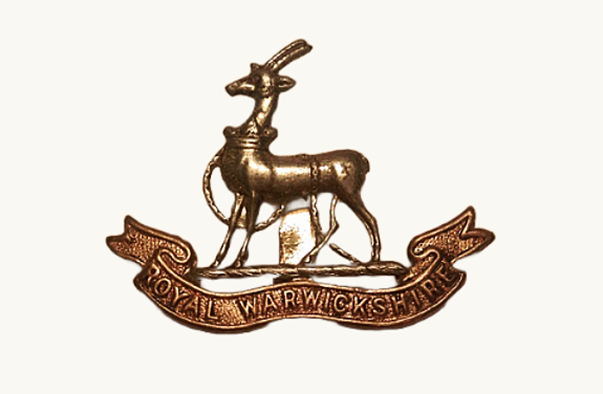
The Battalion Battle Patch was a pair of red cotton bars which were worn vertically on each arm, the companies were identified by a strip of worsted tape which would have been worn on the epaulette, each company had the following colours, H.Q. Company – a mixture of all company colours which went in the following order blue, red, yellow and green, A Company – blue, B Company – red, C Company – yellow and D Company – green.
At the outbreak of war in August 1914, 6th Battalion, Royal Warwickshire Regiment (RWR) was part of the Warwickshire Infantry Brigade of the South Midland Division. The South Midland was one of the 14 divisions of the Territorial Force. By early 1915 the battalion was designated 1/6th RWR, and was a constituent part of 143 Infantry Brigade, 48th (South Midland) Division. Other units in the same brigade were: 1/5th, 1/7th and 1/8th Battalions RWR. The division sailed for France in March 1915.
My Great Grandfather Henry Nichols was born on Tuesday 26th January 1886 to Richard Nichols (aged 42) and Eliza Nichols (Jeacocks) (aged 36) in Earlsdon, Coventry. On Tuesday 21st September 1886, Henry was baptised at St. Thomas’s Church in Earlsdon. During 1891, a census was taken which lists Henry as a child of five years of age and during the same year Henry’s sister Mabel Nichols was born.
Between 1904 and 1911, Henry Nichols became a Salvationist and bandsman with The Coventry City Salvation Army Band where he played both the Cornet and Flugel Horn. In 1904 the band started to save for a new set of instruments and raised over £36.00 over the Christmas of 1904 under the leadership of Bandmaster Robert Minton. Each bandsman was given a set of greetings cards and were assigned to distribute these cards to streets within their local area. For the carolling period the band was split into three groups, where carolling's were both played and sung on various streets around Coventry which often took place after a long day at work for many of the bandsmen. Over two Christmas periods the band raised £70.00 with the band league raising a further £40.00 with other concerts and donations giving a total of £200.00 towards the new band's instruments. The £100.00 shortfall was met by two bandsmen (a full set of Salvation Army instruments cost around £315.00 in total).
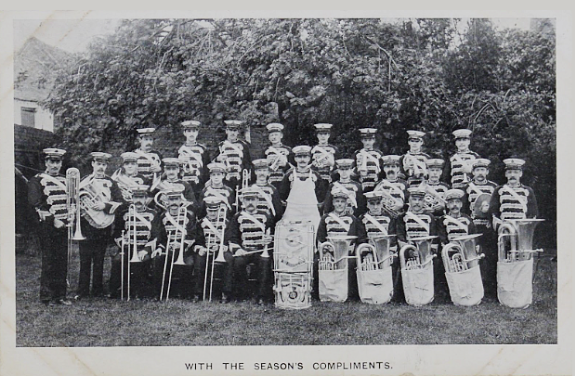
Picture no.1
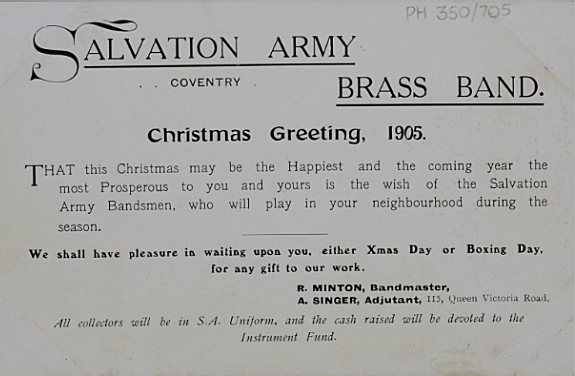
Picture no.2
In 1907, the band numbered around 36 players and were asked to spend a weekend in London which was known to be a hotspot of Salvation Army banding. The band's first concert of their time in London was at The Chalk Farm Salvation Army Corp also known as the farm where Bandmaster Punchard stated that “the playing all round was good and there was ample evidence of careful working out of pieces”. The band played again at the Monday night festival at The Regent Hall Salvation Army Corps also known as the rink alongside The Chalk Farm Salvation Army Band and The Regent Hall Salvation Army Band, a comment by a member of The International Staff Band stated that “Coventry Band was a surprise to many and it drew notice to the new emerging musicians”.
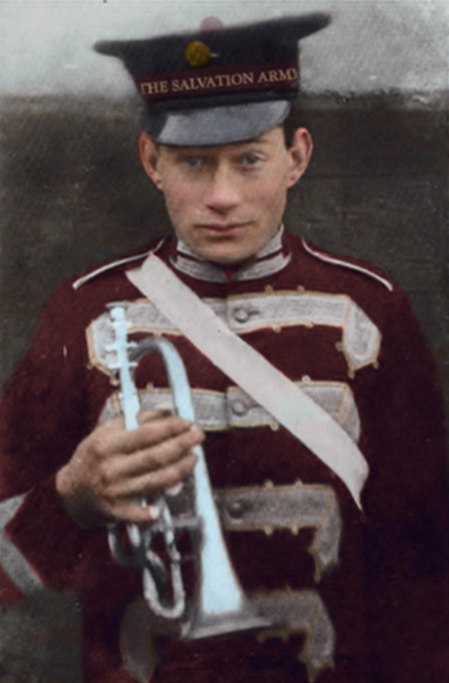
Picture no.3
On the 19th December 1908, William Booth, the founder of The Salvation Army made a visit to Coventry and stated 'When we get up to the celestial city we shall say, what is the bright shining star up there? The reply will come back, tis a Coventry Bandsman'.
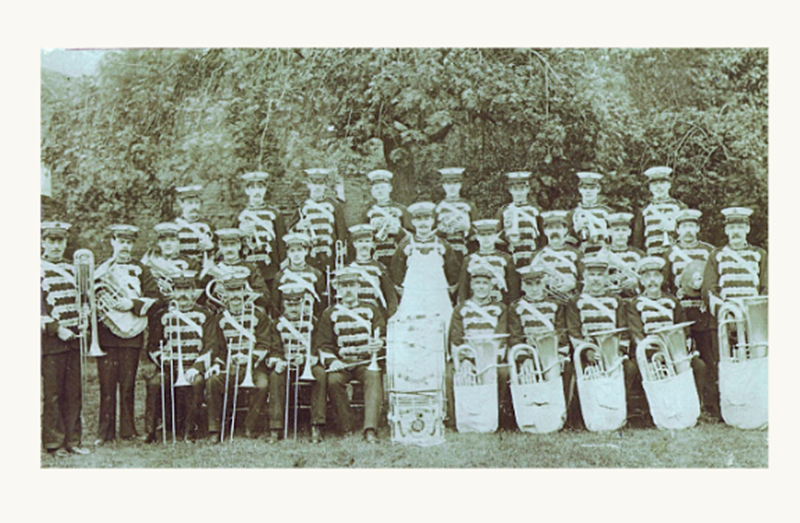
Picture no.4
In 1909, Bandmaster Robert Minton resigned from the band for personal reasons and was replaced by Bandmaster Walter Coombes. In July 1909, the band conducted a pre-tour festival which included well known works for brass band including ‘Vesper Hymn’, ‘Chalk Farm’ and ‘Regent Hall’ Marches alongside selections including ‘Welsh Melodies’ and ‘Songs of Scotland’. Between Saturday 31st July 1909 and Saturday 7th August 1909 the band went on their first tour of Scotland via train visiting Anderton Govan, Paisley, Clydebank, Greenock, Gournock, Port Glasgow and finally Pollockshaw. On Sunday 1st August 1909 whilst the band was holding an open air service in Govan there was an estimated 60000 people in attendance.
The next major tour for the band happened around the August Bank Holiday in 1910, although there was some slight worry that this would go ahead as Bandmaster Robert Minton had injured his lead and the night before the tour was to commence Bertie Bertenshaw (who was a Bass Drummer in the band) father passed away the night before the tour and was unable to accompany the band.
The band travelled to St. Peter’s Port, Guernsey where it held a bandstand on the evening of Saturday 27th August 1910. The following day, on Sunday 28th August 1910, it was estimated that the band had already played to around 6000 people. On Monday 29th August 1910, the band played at St. Paul’s Church where the audience enjoyed the band's singing. On Tuesday 30th August 1910, the band travelled to L Islet where two festivals were held before leaving early on the morning of Wednesday 31st August 1910, to travel to St. Helier where two final concerts of the tour were held. The band returned to Coventry on Friday 2nd September 1910, arriving back at 11:30pm in an extremely tired state.
On Saturday 26th November 1910, at 24 years of age, Henry Nichols married Mary Elizabeth Hobley at St. Thomas’s Church in Earlsdon, Coventry and moved into their new house at 98 Westwood Road in Earlsdon. Henry’s best man at his wedding was William John Sherwin who also happened to be a bandsman in The Coventry City Salvation Army Band.
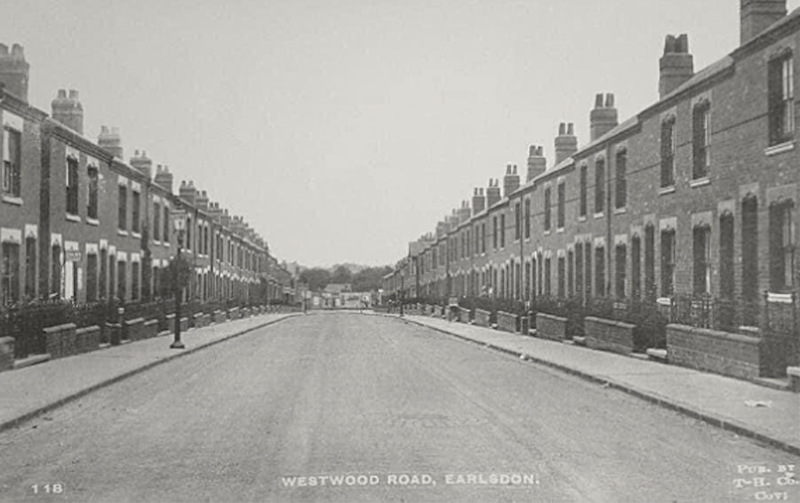
Picture no.5
The following year on Saturday 25th November 1911, Mary (aged 18) and Henry’s (aged 25) first child was born which was a little girl who was later named Agnes Elizabeth Nichols or Annie for short. Two years later on Thursday 29th May 1913, Mary and Henry’s second child, Victor Henry Nichols was born. Both children were baptised in Stretton Upon Dunsmore.
On Tuesday 4th August 1914, British declared war on Germany, at this time Henry was living in Brinklow with his wife and two children and working and residing in Coventry during the weekdays. On Monday 7th September 1914, Henry Nichols attended the recruiting station in Rugby and joined The 12th Service Battalion, The Rifle Brigade being given the service number S/1208 and being sent to Brownlett Camp for training where he was assigned to D Company. At this time Henry was 28 years and 7 months and his height was 5 feet 4 5/8 inches, Henry weighed 112 pounds and had a waist size of 34 inches his eyes were described as being brown and his hair described as being dark with an overall dark complexion. Before joining up Henry had had a variety of different jobs including being a milkman but before joining he had been working as a labourer which suggests that times may have been hard for Henry and his family. Henry was vaccinated in October 1914 but after 32 days of training on Thursday 8th October 1914, Henry was discharged from the army due to his teeth which was an essential requirement for soldier’s who may have to eat hardtack which had a reputation for being so hard that it could break teeth if not soaked before being eaten. A positive twist in this story is that in May 1915, Henry’s third child, Olive Christina Nichols was born on Thursday 29th April 1915.
At the beginning of March 1916, Private Henry Nichols visited the recruiting office in Coventry and reported to Budbrooke Barracks for his initial training, having joined The 1/7th Battalion, The Royal Warwickshire Regiment. After an initial period of training, Henry was posted to France and No.29 Infantry Base Depot at Rouen for further training before being posted to The 1/6th Battalion, The Royal Warwickshire Regiment with service number 20731.
August 1916
At the end of July, The 143rd Infantry Brigade stated that there had been 8 officers and 128 men killed in action (this figure includes men missing in action) and 12 officers and 391 men wounded in action with 3 officers wounded in action in the month of July 1916. The total fighting strength of The 1/6th Battalion, The Royal Warwickshire Regiment on Monday 31st July 1916 was 42 officers and 643 other ranks.
The 1/6th Battalion, RWR, began August 1916 in training in Maison Rolland, where Captain T.H Lawley joined the battalion for duty on Tuesday 1st August 1916. On Friday 4th August 1916 and Monday 7th August 1916, 8 and 5 other ranks respectively joined the battalion. On Wednesday 9th August 1916 the battalion ate breakfast and then at around 6:05am marched to Gezaincourt the following day at around 6:19am the battalion marched to Lealvillers where 48 other ranks joined the battalion. The following days were spent in training, on Saturday 12th August 1916, 2nd Lieutenant F.T.J Belcher joined the battalion and on the following day 2nd Lieutenant A.E. Clarke was confirmed as being held as a prisoner of war.
On Monday 14th August 1916, the battalion marched to Bouzincourt setting off at around 8:00 am where 2 other ranks joined the battalion for duty. On Wednesday 16th August, the battalion moved into the line between Ovillers and Thiepval, relieving The 1/4th Battalion, The Gloucester Regiment from The 144th Infantry Brigade. Guides (which the battalion met at 2pm) from The 1/4th Battalion, The Gloucester Regiment guided the battalion up the line from Crucifix Corner (map reference W.11.D.1.9). The 1/7th Battalion, RWR was on the left of the battalion and The 1/4th Battalion, The Oxfordshire and Buckinghamshire Light Infantry were on the right of the battalion. Three men were killed in action and ten men wounded.
One of these men was Private George Lefley (4520) who has no known grave and is remembered on The Thiepval Memorial to The Missing.
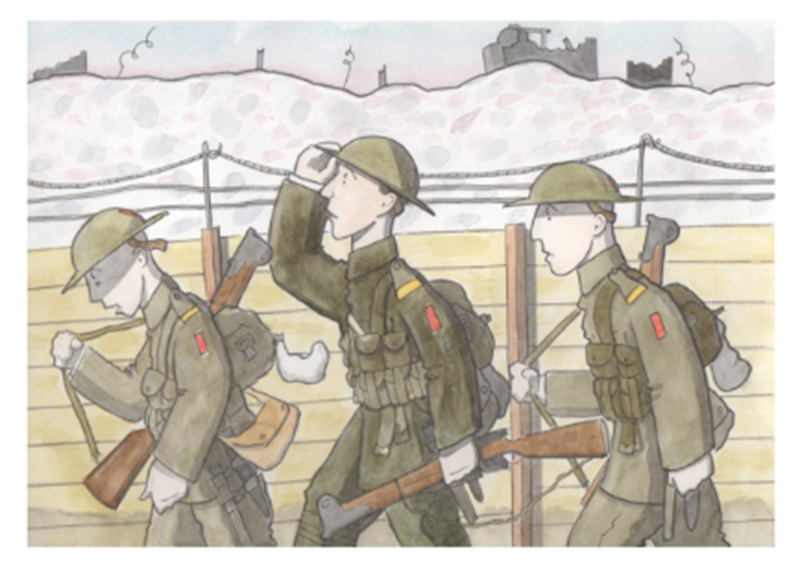
Picture no. 6
On Thursday 17th August 1916, a counter attack was launched by the Germans but was stopped by the artillery, 2nd Lieutenant B.J.W Purchase and 2nd Lieutenant A.P. Haggo were wounded in action with 2nd Lieutenant Haggo remaining on duty, three other ranks were killed in action and eleven men wounded in action who included;
Private William Alfred Cordin (5154) who was 21 years of age at the time of his death.
Private Henry Richard Boffin (4928).
Private Arthur Roberts (5182).
Lance Sergeant Alfred Whitehouse (1797).
The above individuals have no known graves and are remembered on The Thiepval Memorial to The Missing.
The below individuals were exhumed and reburied by a Canadian burial party on 12.05.1919 at Pozieres British Cemetery at Ovillers La Boisselle.
Private R. Hughes (5012) - 57D.X.3.5.
Private A. Cunningham (5312) - 57D.X.3.5.
Private F.A. Begley (4806) 57D.X.2.B.Y.32.
An unknown British Soldiers from The 1/6th Battalion, RWR were found at the following location, 52D.X.2.B.W.12.
On Friday 18th August 1916, The 1/6th Battalion, RWR took part in an attack in conjunction with The 1/5th Battalion, RWR and The 4th Battalion, The Royal Berkshire Regiment on the right.
The attack was to begin at 5pm with the objectives being located around at X.2.B.
The first objective was located between points X.2.A.9.6. inclusive to X.2.B.04-03-20.
The second objective was located between points X.2.B.55 inclusive to X.2.B.44.
The third objective was located between points X.2.B.59., X.2.B.48 and X.2.B.06.
The advance was ordered to go in waves with the first wave capturing, consolidating and reforming on the first line allowing successive waves to push on to the second objective. The 6th Battalion, RWR was ordered to push on to the third objective.
Assaulting troops were ordered to move as light as possible and were ordered to carry 120 rounds of small arms ammunition, 2 mills bombs and two sandbags, the men also had white distinguishing badges on their back to aid in identifying where the troops were. Officers were also ordered to dress like the men to make themselves less of a target. The trench at map references X.2.D.28-26-20 was ordered to be kept clear for the evacuation of casualties. The attack was due to go in at around 5pm.
D company was ordered to attack the first two objectives and C company the third objective with the possibility of C company further pushing up to R32.D.1.2. and R32.C.9.1. B company was ordered to attach one platoon to both C and D companies who were to be used to carry tools and sandbags. Also a party of twenty men from B Company were to be attached to The 143rd Trench Mortar Battery to be used for carrying ammunition. The remaining parts of B Company were to be located between points 47 and 77 and A Company was to be located between points 44 and 10. The battalion HQ was located at point 47 for the attack.
During the attack the battalion was held up for a short time by a German strongpoint on the right of the battalion's advance but the battalion later went on to achieve all of their objectives. The Battalion captured six German officers and two hundred and forty five other ranks during their attack; this number included a large number of Non Commissioned Officers.
During the attack Captain R.C. Lowe, Lieutenant C.J. Crockett, 2nd Lieutenant, A.J.B. Pearson, 2nd Lieutenant H.S. Skillington (attached from The 4th Battalion, The Northamptonshire Regiment), 2nd Lieutenant J. Lomax (attached from The 3rd Battalion, The Duke of Cornwall Light Infantry) and 2nd Lieutenant A.P. Haggo (attached from The 4th Battalion, The Royal Scottish Fusiliers) who had been slightly wounded a few days earlier were killed in action with Captain B. Hargreave, 2nd Lieutenant Seddon and 2nd Lieutenant Shelton wounded in action. Overall 23 other ranks were killed in action and a further 90 men were wounded in action with 10 men missing in action.
The men killed in this action are as follows.
Thiepval Memorial to The Missing:
Private Wilfred Griffiths (243130) presumed missing but later confirmed as killed in action.
Private George William Terry (5424).
William Arthur Harrison (5165) part of C Company at 32 years of age.
Private Frank Louch (5226).
Private Harry Hancox (5219) at 33 years of age.
Private Thomas Cross (5081) at 30 years of age.
Private Walter Lichfield (3176) at 25 years of age.
Private Albert Clayton (3358).
Private William Binns (241341) presumed missing but later confirmed as killed in action at 19 years of age.
Private George Frederick Johnson (5065) at 26 years of age.
Private Francis Jones (241564) presumed missing but later confirmed as killed in action.
Private Harold Louis Knight (20822) killed in action at 16 years of age.
Lance Corporal Percy William Hodgetts (4227).
Private William Harold Kiddle (5421).
Private Alfred Meridith (241644) presumed missing but later confirmed as killed in action.
Private Alfred John Toy (5188) at 25 years of age.
Lance Sergeant Jack Addison Thorburn (3064).
Private Joseph Thomas Watts (241608) - presumed missing but later confirmed as killed in action.
Private Edward James Millerchip (5174) at 22 years of age.
London Cemetery and Extension:
Private Francis John Day (5208) at 34 years of age. The body of Francis John Day was recovered from map reference 57D.X.2.B.70.05. Francis was found wearing his uniform, boots with a pair of 6 (T) R.Warwickshire titles which were located in his pocket and dentures and was identified by a W.P Document which was marked F.J. Day, 1/6 R.W.R. 5208.
Pozieres British Cemetery at Ovillers La Boisselle:
Private L. Delahunt (4574) was 19 years of age and originally buried at map reference 57D.X.2.B.V.70.4575.
Private Charles Edwin Glenn (5278) at 34 years of age and originally buried at map reference 57D.X.2.B.V.44.
Private A. Dukes (5089) was originally buried at map reference 57D.X.2.B.W.12.
Private W. Westley (5102) was originally buried at map reference 57D.X.2.B.W.18.
Private H.L. Parsons (1607) was originally buried at map reference 57D.X.2.O.L.5.
Private F Payne (2173) was originally buried at map reference 57D.X.2.B. (52, 62 or 82).
Private H.J. Massey (2173) was originally buried at map reference 57D.X.2.B.69.
Captain Richard Conway Lowe aged 22 years old was originally buried at 57D.X.2.B.V.91 buried under a battalion cross, when he was exhumed on 12/05/1919 his identification disc was forwarded to a base depot.
Corporal G. Mills (2572) was originally buried at map reference 57.D.2.B.7.6.5.
The following day on Saturday 19th August 1916, the battalion spent time consolidating their captured positions, the battalion war diary reported that three men were killed in action with a further seven men wounded and two men missing. During the night the battalion moved slightly to the left.
Thiepval Memorial to The Missing:
Private Ernest Sewell (4774) at 20 years of age.
Company Sergeant Major George Henry Dawe (1495) at 22 years of age.
On Sunday 20th August 1916, the battalion was relieved by The 1/7th Battalion, The Worcester Regiment. The battalion moved back to Bouzincourt, the war diary records that three men were killed in action and a further seven men wounded with eight other ranks arriving as reinforcements for the battalion.
Thiepval Memorial to The Missing:
Corporal George Holland (2077).
Bouzincourt Communal Cemetery:
Corporal T. Wright (1619).
Monday 21st August 1916 was spent at rest with thirty five other ranks arriving to reinforce the battalion.
On Wednesday 23rd August 1916, the battalion moved to Ovillers and were ordered to station two companies at Usna Redoubt and two companies in the support trenches in Ovillers. The war diary records that 2nd Lieutenant C.F. Seddon and 2nd Lieutenant W.S. Cattell was suffering from slight shell shock and that there had been six other ranks wounded.
The following day on Thursday 24th August 1916, the battalion relieved The 1/7th Battalion, RWR in the trenches north of Ovillers, the war diary reports that four men were killed in action and seven men were wounded in action.
Thiepval Memorial To The Missing:
Private Samuel Russell (20739) at 21 years of age.
Private Frank Adams (4571) at 19 years of age.
Private Arnold Leslie Hasler (20720).
Private John Bastable (20705) at 34 years of age.
On Friday 25th August 1916, the battalion were in the trenches and suffered four men killed in action and six men wounded in action.
Thiepval Memorial to The Missing:
Private Edward James Cramp (5111).
Private Percy Deakin (4191).
Private Enoch Hollis (5168) at 33 years of age.
Private George Harold Willets (1860).
On Saturday 26th August 1916, after four days in the line the battalion was relieved by The 1/7th Battalion, RWR and moved back to Bouzincourt suffering one man killed in action and six men wounded in action.
Thiepval Memorial to The Missing:
Private William Whyment (20746) at 22 years of age.
The Battalion spent Sunday 27th August 1916 resting with twenty two other ranks arriving to reinforce the battalion. On Monday 28th August 1916, the battalion marched to hutments at Varennes. 2nd Lieutenant J. Harrison, 2nd Lieutenant S.E. Bowden and Lieutenant G.H.O. Easterbrook from The 5th Battalion, The Devon Regiment joined for duty. The following day the battalion marched to Bois De Warnemont and spent the rest of the month in training.
The 143rd Infantry Brigade noted that 6 officers and 42 men had been killed in action, 7 officers and 152 men had been wounded in action and 14 men were missing in action during the month of August, this was again the highest casualties sustained by any infantry battalion in The 143rd Infantry Brigade. At the end of the month the battalion had a fighting strength of 32 officers and 604 other ranks.
September 1916
On Saturday 2nd September 1916, the battalion marched to Vauchelles and were inspected the following day by G.O.C commanding The 48th South Midland Division. On Wednesday 6th September 1916, the battalion was visited by General H De La P. Gough commander of the reserve army. On Saturday 9th September 1916, 2nd Lieutenant C.F. Seddon returned to duty. On Monday 11th September 1916, the battalion moved with the brigade in artillery formation to new billets in Gezincourt.
The battalion continued to train and receive reinforcements with Captain Bowater arriving on Thursday 14th September 1916. On the Sunday 17th September 1916, the battalion received news that Captain L.C. Crockford had been awarded the Military Cross and that Corporal J.V. Haseler had received the Distinguished Conduct Medal. The following day the battalion moved to billets in Prouville. On Tuesday 19th September 1916, eight officers arrived including Captain E.R. Johnson, 2nd Lieutenant G.H. Draper, 2nd Lieutenant J.B. Musgrave all from The 4th Battalion, The Cheshire Regiment and Captain G. Linfoot, Lieutenant C.H.B. Seel, Lieutenant F.A. Godwin and 2nd Lieutenant R.B.W. Gosse from The 7th Battalion, The Cheshire Regiment.
On Friday 29th September 1916, the battalion marched to Mondecourt and the following day marched to Bayencourt where Captain E.R. Johnson transferred to The 15th Battalion, The Royal Warwickshire Regiment.
October 1916
The beginning of October 1916 saw the battalion based in Bayencourt where working parties were supplied to the Herbuturne sector of front. On Monday 2nd October 1916, A company was attached to The 1/5th Battalion, The Royal Warwickshire Regiment. On Wednesday 4th October 1916, three companies were moved to Chateau De Haie. The following day the battalion marched to St. Amand where A company rejoined the battalion and where training took place. On Saturday 7th October 1917, 2nd Lieutenant F.T. Swiman joined the battalion.
On 12th October 1916, the battalion returned to the front line in the left sector at Hebuterne relieving The 1/7th Battalion, The Worcester Regiment in the line between map reference K.4.C.1.1. and K.3.D.3.6. The battalion was attached to The 144th Infantry Brigade with B company in the front line, H.Q Company and D Company in Hebuterne and A and C company in Fonquevillers. The battalion were relieved on Monday 16th October 1916 by The 1/6th Battalion, The Gloucester Regiment and had suffered three men killed in action and ten men wounded in action of which three men had later died of their wounds. The battalion rejoined The 143rd Infantry Brigade on Monday 16th October 1916 and went into billets at St. Amand.
Saturday 14th October 1916
Walencourt Halte British Cemetery, Saulty:
Private J Tomlinson (20891).
Hebuterne Military Cemetery:
Private William Coward (5156) at 28 years of age.
Sunday 15th October 1916:
Walencourt Halte British Cemetery, Saulty:
Private G.H. Coupe (5152) at 24 years of age.
Corporal A. Wier (1682).
Hebuterne Military Cemetery:
Company Quartermaster Sergeant B.S. Wardley (2785).
Company Sergeant Major T. Waldron (1732).
Monday 16th October 1916:
Walencourt Halte British Cemetery, Saulty:
Private A. Gascoigne (20717)
On Thursday 19th October 1916, the Military Medal was awarded to Private C.V. Taylor (2583). The following day the battalion moved to Grand Roullecourt at around 10;34am. On Sunday 22nd October 1916, the Military Medal was awarded to Lance Corporal G. Tulip (20862) and Private Deaham (10290). The battalion was on the move again on Wednesday 25th October 1916 where they were transported by motor to Baizieux the following day the battalion marched to camp at Becourt and on Friday 27th October 1916 the battalion moved into camp at Mametz Wood where they were ordered to meet at the road junction at map reference S.14.B.0.7. at 7am. where working parties were supplied to work on the roads in the surrounding area.
November 1916
On Wednesday 1st November 1916, the battalion moved into billets in Albert and on Friday 3rd November 1916, the battalion moved to Peake Wood Camp near Fricourt and provided working parties before relieving The 7th Battalion, The Worcester Regiment as the right support battalion on Thursday 9th November 1916 near Martinpuich, guides from The 7th Battalion, The Worcester Regiment guided the battalion up to the front line from map reference S.8.A.8.8. The following day the battalion provided working parties and between Friday 10th and Saturday 11th November 1916 suffered two men wounded in action. On Saturday 11th November 1916 around 11pm, the battalion relieved The 1/5th Battalion, RWR in the front line close to Le Sars and suffered one man killed in action (recorded as being killed on Sunday 12th November 1916) and one man wounded in action. Private Stanley Williamson (5585) is remembered at The Thiepval Memorial to The Missing. All battalions moving up into the front line were ordered to take 48 hours worth of rations, with battalions in the support trenches being ordered to take 24 hours worth of rations into their positions.
On Monday 13th November 1916, the battalion suffered one man wounded with Major J.R. Nuttall joined the battalion. On Tuesday 14th November 1916, Captain R.S. Partridge was wounded in action with a further seven other ranks being recorded as being wounded in action.
The battalion were relieved around 10pm on Tuesday 14th November 1916 by The 1/5th Battalion, The Gloucester Regiment and marched back to Shelter Wood Camp near Fricourt located at map reference X.22.C.27.. The following day working parties were provided with one man being wounded in action. Between Saturday 18th November 1916 and Friday 24th November 1916, the battalion was in division reserve and provided various working parties. Captain R.S. Partridge rejoined the battalion on Friday 24th November 1916.
On Friday 24th November 1916, 2nd Lieutenant Tonking, 2nd Lieutenant R.A. Stevenson, 2nd Lieutenant C.J. Meyers, 2nd Lieutenant W.C. Williams, went to The 10th Battalion, The Royal Warwickshire Regiment.
On the night of Friday 24th November 1916 and Saturday 25th November 1916, the battalion relieved The 1/8th Battalion, The Worcester Regiment as the left support battalion. B and C companies were located forward with H.Q., A and D companies located in the village of Martinpuich. Captain J.N Stafford joined the battalion for duty along with thirteen other ranks. For the following two days, the battalion provided working parties and suffered one man killed in action and one man wounded in action. Private C. Concannen (1773) was buried in Martinpuich British Cemetery.
The battalion relieved The 1/5th Battalion, RWR on Tuesday 28th November 1916 and the following day suffered one man killed in action and eight men wounded in action. Private Charles Thomas Worrall (20894) is remembered on The Thiepval Memorial to The Missing.
December 1916
The beginning of December 1916 saw the battalion still in the front line around Le Sars where one man was wounded on Friday 1st December 1916. On Saturday 2nd December 1916, at around 9:30 am a German patrol wandered into a Lewis gun post killing two men and wounding two men, the post was immediately counter attacked and retaken by a party under the command of Sergeant Windmill, two men are believed to have been wounded in this action. This action was later recorded as being part of a German raid on the position, with the German raiding party being forced to retreat without having made any gains. The German raiding party had entered the British post at Scotland Trench around map reference M.16.A.5.9.
The bodies of the men killed in this action were either never recovered or their graves have been lost and they are now remembered on The Thiepval Memorial to The Missing. The members of the Lewis gun crew killed in action were Private Richard William Adams (5197) and Private George William Hill (4530) who was 20 years of age at the time of his death.
On the evening of Saturday 2nd December 1916, the battalion was relieved by The 1/8th Battalion, The Worcester Regiment. During the relief the battalion suffered one man killed but managed to move to Pioneer Camp close to Contalmaison without further incident, Private H. Kettle (20330) is buried at Contalmaison Chateau Cemetery and was 34 years old at the time of his death.
The battalion went into divisional reserve and provided working parties but were soon called to relieve The 1/4th Battalion, The Gloucester Regiment as the left support battalion on the evening of Wednesday 6th December 1916 close to Martinpuich. On the evening of Friday 8th December 1916, the battalion relieved The 1/5th Battalion, RWR as the centre front battalion at Le Sars. A raid which was organised to take place in the early hours of Saturday 9th December 1916 was postponed until 6:30pm. The raiding party departed from Scotland trench (M16.A.8.8.) with the objective of raiding the copse located at map reference M.10.D.1.2. in the aim of inflicting casualties and capturing prisoners. The raid resulted in the capture of four other ranks of The 1st Battalion, The Marine (SIC) Division, two German other ranks gave themselves up to the battalion on the left. The party was led by Captain R.S.Partridge (covering party consisting of seven other ranks) and 2nd Lieutenant Grosse (storming party consisting of one sergeant and thirteen other ranks) and consisted of twenty three other ranks, suffering one man wounded in action. The following day the battalions suffered three men killed in action and five men wounded in action.
Warlencourt British Cemetery:
Private E. Hill (20911)
Walter Coombes (5367) at 20 years of age.
Thiepval Memorial to The Missing:
Lance Sergeant Ernest Albert Etheridge (20851) at 19 years of age.
Martinpuich British Cemetery:
Sergeant P. Harris (2718).
Private E. Berry (20901) at 34 years of age.
On the evening of Sunday 10th December 1916, the battalion was relieved by The 1/4th Battalion, The Gloucester Regiment. The battalion went into divisional reserve and on Tuesday 12th December 1916, Military Medals were awarded to CSM Dawe (1495), Corporal Bardell (2624), Corporal T.E. Beastall (2759), Private D.A. Coates (1374), Corporal H.W. Davies (2672), Sergeant W. Higgs (338), CQMS A. Smith (230) and Sergeant H. Smith (1266). The following day, W.M. Pryor from The 2/1st Battalion, The Hertfordshire Regiment joined the battalion for duty.
On Thursday 14th December 1916, the battalion was relieved by The 10th Battalion, The Scottish Rifles and marched to Becourt starting at around 9:50am with one hundred yard intervals between each platoon, 1nd Lieutenant Harrison was left behind with one junior N.C.O. to hand over to the incoming unit, it was also announced that for his actions on Saturday 2nd December 1916, that Sergeant C. Windmill (2799) was awarded to Military Medal.
On Friday 15th December 1916, the battalion moved to Millencourt in full marching order for rest and training, On Thursday 21st December 1916, Captain R.S. Partridge was awarded the Military Cross. The rest of the year of 1916 was spent in training.
Biaches
Biaches is a village which lies on the south bank of the River Somme facing the town of Peronne and is located in the Somme department of the Hauts-de-France region. Biaches was captured between Sunday 9th July 1916 and Monday 10th July 1916. A German counter attack supported by a flamethrower was made on Saturday 15th July 1916 and resulted in part of the village being recaptured but after a French counterattack made on Sunday 16th July 1916 these losses were regained.
Around six counter attacks were made at La Maisonette which was also known as Hill 97. On the Monday 17th July 1916, a German counter attack fully recaptured the village of Biaches but the village was recaptured by French forces on Wednesday 19th July 1916. This heavy fighting saw the village and the surrounding area reduced to rubble.
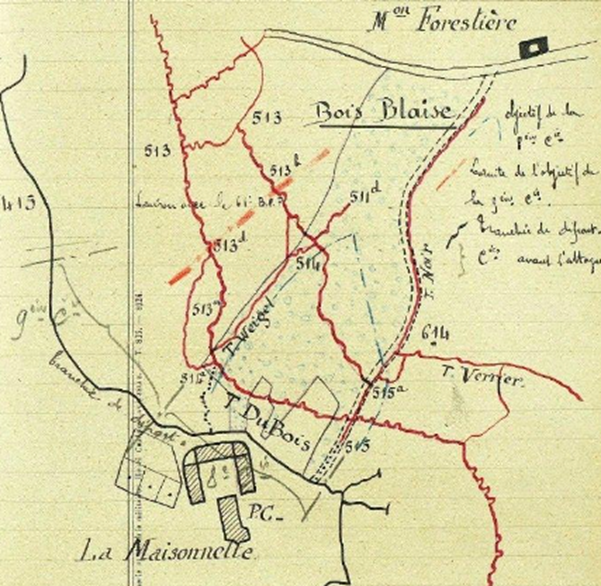
Picture no. 7
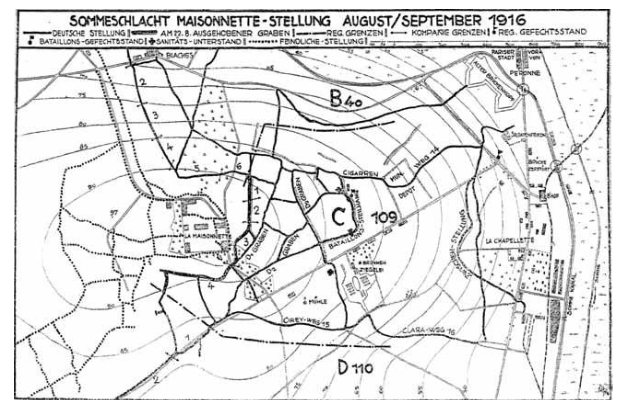
Picture no. 8
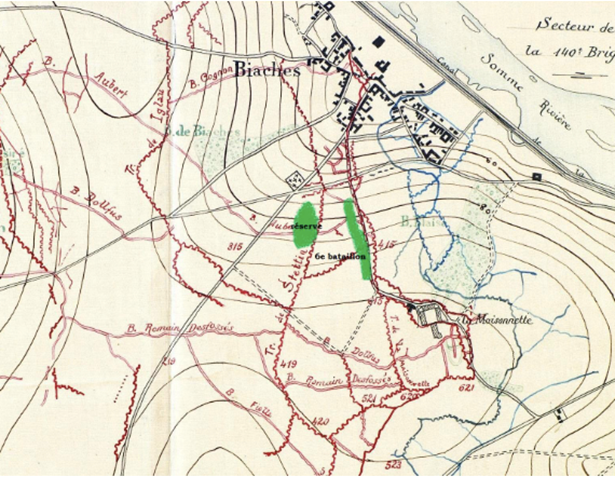
Picture no. 9
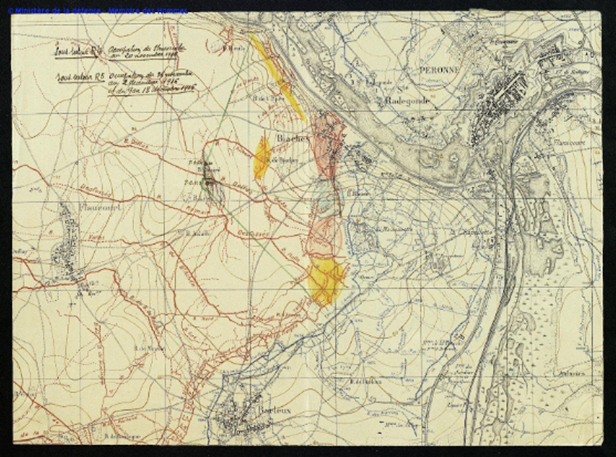
Picture no. 10
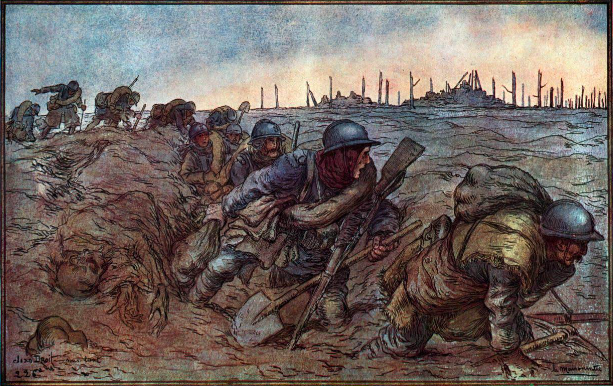
Picture no. 11
January 1917
The beginning of 1917 saw The 143rd Infantry Brigade training on the No.5 Training Area.T he 1/6th Battalion, RWR was based in Warloy, On 8th January 1917, The 1/6th Battalion, The Royal Warwickshire Regiment prepared to move from their training area in Warloy Baillon to Liercourt via Mericourt L'Abbe by train to Airaines. On 27th January 1917, the men of The 1/6th Battalion, The Royal Warwickshire Regiment moved to Cerisy by train and then marched to Mericourt-Sur-Somme. Throughout January, the battalion received 250 other rank reinforcements and were joined by 2nd Lieutenant A .R Drowning on Tuesday 9th January 1917.
Preparations for moving back up to the front line were constantly in motion, a document entitled ‘Scheme of Medical Arrangements In The Event Of Heavy Fighting’ located within the war diary of The Assistant Director of Medical Services who was a Colonel C.A. Young notes that Regimental Aid Posts (RAP) which were to support the units of The 143rd Infantry Brigade were to be located at the following map coordinates 62C.H.30.D.3.2., 62C.H.30.C.3.1. and 62C.H.21.A.9.4. these locations were stated as being there to support the battalions in the left sector with regimental aid posts being set up for the right sector. Each Regimental Aid Post was allotted ten bearers from The Royal Army Medical Corps with a hundred bearers operating between The Regimental Aid Posts, The Royal Army Medical Corps Posts and The Advanced Dressing Stations. Stretcher bearers from The Royal Army Medical Corps were ordered to assist regimental bearers with bringing in the wounded from the forward posts to The Regimental Aid Posts with fresh sets of bearers being provided until the casualty reached the Advanced Dressing Station at Flaucourt and from here seriously wounded casualties would be moved at night by motor ambulance to a Main Dressing Station via Herbecourt and Eclusier, all ambulances were ordered to return to Flaucourt via the Cappy Chateau – Herbecourt Roads.
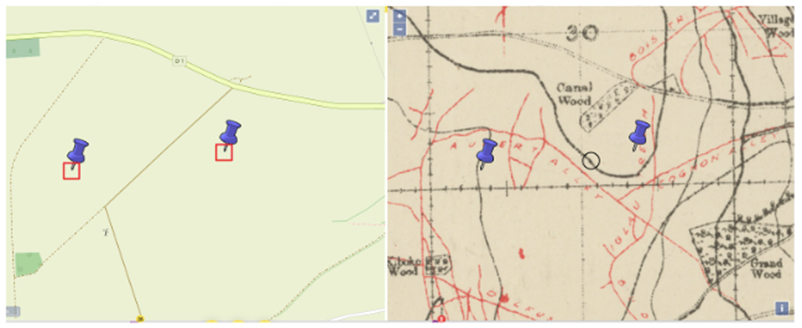
Picture no. 12
Field Ambulance Posts (FAP) were set up in the trenches at Desire Post (62C.H.36.C.2.5.) which had the capacity for twenty stretcher cases, Achille Post (62C.N.5.A.7.7.) which had the capacity for twelve stretcher cases and Guerrier Post (62C.H.29.B.8.1.) which had the capacity for two stretcher cases. An Advanced Dressing Station (ADS) was set up in Flaucourt at 62C.N.4.A.3.3. which had a capacity for 25 stretcher cases.
The Main Dressing Stations (MDS) were set up and manned with The 1/3rd South Midland Field Ambulance located in Eclusier at map coordinates 62C.G.15.C.2.4. which had accommodation for four hundred lying cases. The 1/1st South Midland Field Ambulance was located in the Mairie in Cappy at map coordinates 62C.G25.B.3.5. which had the accommodation for three hundred lying cases and finally The 1/2nd South Midland Field Ambulance was located in the south of Cappy at map coordinates 62C.G.25.D.2.4. and had the accommodation for three hundred lying cases. Temporary accommodation was also found for two thousand sitting cases in the village of Cappy which was located close to The 1/1st South Midland Field Ambulance which as stated previously was located in the Mairie in Cappy. A Divisional Collection Station (DCS) was also located at map coordinates 62C.H.32.A.1.9.
February 1917
On the night of Thursday 1st February 1917, 1/6th Battalion RWR assembled and marched along the road from Herbecourt, travelling from Cappy to Biaches to relieve the 2nd Battalion of the 125th French Infantry Regiment which was based in the trenches to the south of Biaches. Three companies were in the line with one company left at Eclusier as a working company.
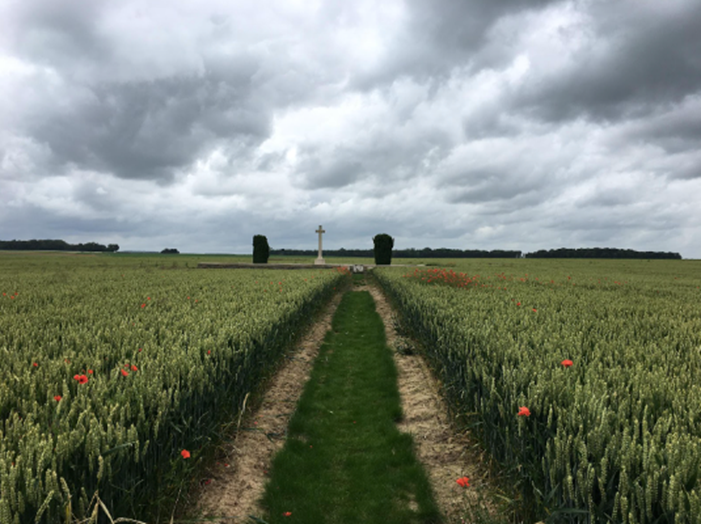
Picture no. 13
In the book ‘Some Desperate Glory’ author Edwin Campion Vaughan (who served with The 1/8th Battalion, The Royal Warwickshire Regiment) describes the scenes around Biaches in February 1917, he writes on Friday 2nd February 1917 that;
'This evening we were engaged in carrying rations and tools and helping to pull the lewis gun cards. It was a very lonely road along which we marched, rising in a gradual slope until we reached the crest of the ridge. Here we had to wait until dusk before we could cross. Around us where we were halted stretched a large dump of wire, stakes, pickets, sandbags, mine timber and all the materials used in trench warfare'.
'After about half an hour of sitting in the snow, and when we were thoroughly hilled, we were able to continue and at 7 o'clock we passed over the ridge and turned off the road onto a narrow track to the right. Ploughing through the snow, we came to the head of a trench, where we halted, it was now quite dark except for the dim light thrown up by the snow. We were not, of course, allowed to smoke and we stood freezing in the wind that blew steadily on to our flank from the icy darkness'.
On Friday 2nd February 1917 and Saturday 3rd February 1917, it was reported that a thin layer of snow lay on the ground with the sun shining brightly, there was intermittent artillery fire which wounded three other ranks and five other ranks respectively.
On Saturday 3rd February 1917, Vaughan states
'At 6 p.m. Thomas and I set out with the company to carry the rations up to the line. This time we went straight up the road leading through Herbecourt. We had passed through the village and were descending the further slope, where all was dead quiet and peaceful, so that as I walked beside Thomas I had no qualms of fear, when he said in a low voice, "if they start shelling, we will have to split up. You take the front two platoons onto the fields on the right and I will take the remainder onto the left"'.
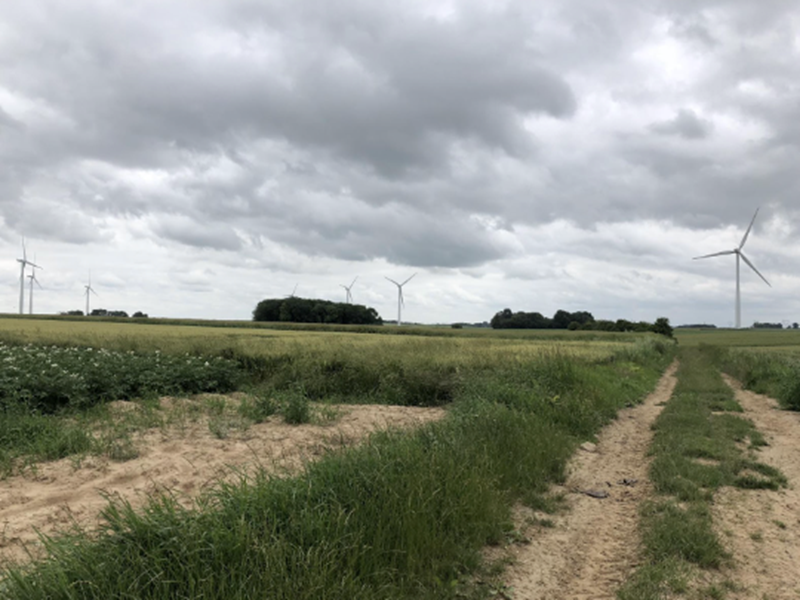
Picture no. 14
On the afternoon of Sunday 4th February 1917, The 1/6th Battalion, The Royal Warwickshire Regiment was heavily bombarded between 12:00 pm and 5 bombardment. During this period dugouts were blocked trapping men inside who due to the intensity of the bombardment could not be freed, where the trenches had not been blown by direct hits lay littered deep with debris. The bombardment was so deafening that orders were not understood. Casualties were all too numerous with the seriously wounded being unable to be evacuated. During this period of heavy artillery bombardment, Private Christopher Coling (21008) who had enlisted in June 1916 alongside other men from his home village of Grandborough was hit by artillery fire and died immediately from his wounds. It was only after the war that relatives of Christopher found out about the true nature of Christopher's death, just over a year later both of Christopher's older Brother, Philip and younger Brother, Arthur would be killed in action. Another soldier, Private Herbert Harold Kenny, who had joined in March 1916, was taking cover in his dug out when it received a direct hit from a German artillery shell and was killed outright. Herbert Kenny may still lie within that small field which faces La Maisonette and is remembered on the Thiepval Memorial.
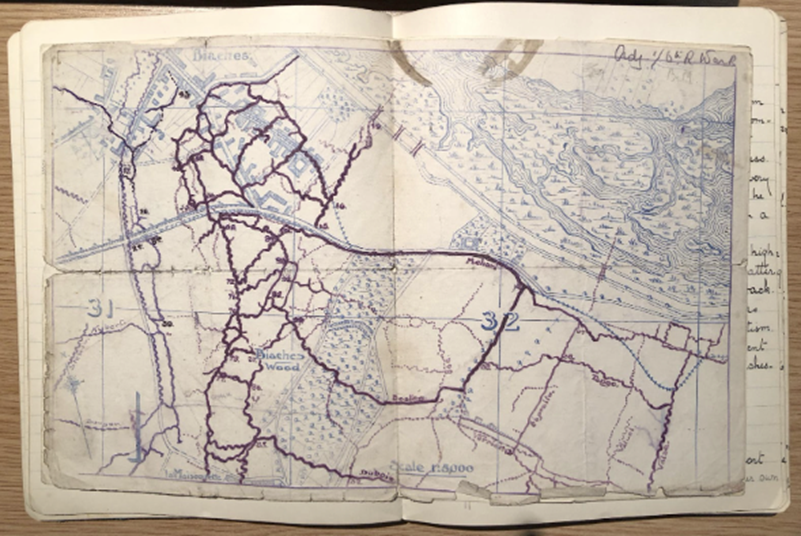
Picture no. 15
Support was provided by French artillery who were in the process of being relieved by the British Artillery of 48th South Midland Division however it was reported that the French Gunners were short of ammunition for their Guns and although British Guns were in position they had not yet registered the s.o.s line.
From 5:40 pm onwards there was an intense barrage which focused on the front line and support trenches including Stetting Trench and the communication trenches leading to and from the front line. At 6:15pm, German raiding parties entered The British Front Line just left of B Company which was designated as the central company in the front line and began to move down the British trenches in both directions. The companies disposition in the front line were as follows C Company on the left, B Company in the centre and D Company on the right with A Company being in reserve in Eclusier. All surviving men of The 1/6th Battalion, The Royal Warwickshire Regiment in the front line manned their Lewis guns and lee enfield rifles and gave rapid fire on the advancing German forces. However, in some places in the line there were woefully few men to defend their positions which were rapidly infiltrated by the German raiding parties. 2nd Lieutenant Belcher along with two serjeants of B Company met the German Raiding Party on the right and proceeded to throw bombs at the German Raiding Party who were held up in their progress. The other party of German raiders withdrew before reaching C Companies designated position. Lieutenant Harrison of C Company took a party of bombers to clear out the trenches, all of whom fell victim to the. incessant artillery fire with the exception being Lieutenant Harrison himself.
By 6.25pm The British Front Line was clear with the exception of the dead and dying of both sides which crowded the trenches. By this time B Company and C Company had cleared the remaining trenches and regained communication with each other. Throughout the night stretcher bearers worked to remove the wounded to the rear. During this period 2nd Lieutenant Belcher was found lying dead where he had made his last stand, he was 17 years old. The Battalion War Diary stated that thirty four men were killed of which four men died of wounds, alongside 66 men wounded and 14 men missing some of whom were captured and others who lay buried in their shelters. It was found that the raid had been conducted by The 1st Prussian Guards. A German was found half blinded by a bomb in the British Lines and another was found dying amongst the British dead.
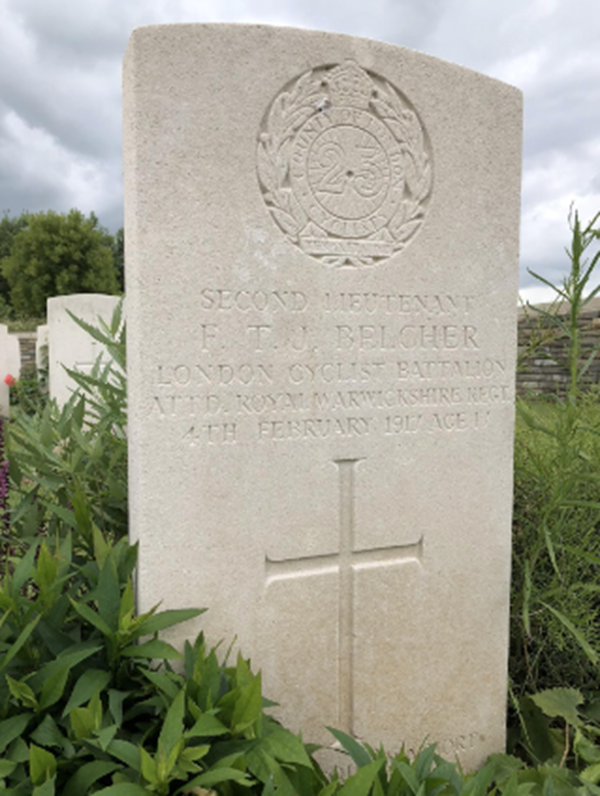
Picture no. 16
The grave of 2nd Lieutenant F.T.J. Belcher who had first joined the battalion on Saturday 12th August 1916 was assigned to B Company at the time of his death. 2nd Lieutenant Belcher was killed alongside two sergeants of his company.
In contrast to this account the German reports written after the war state the following course of events.
To our honoured leader in serious time. This fallen general also created the name Giftpille (which translates to poison pill). We started the attack on February 4th 1917 at 1pm with artillery and minnenwerfer. From planes they checked that the fire was hitting everywhere. at 2:30pm they stopped firing for half an hour then they fired again from 3pm to 3:45pm. We were surprised that the counter fire from the enemy was only weak and without much plan. They shot again from 4:30pm to 5pm and then from 5:30pm to 6pm they started Vernichtungsfeuer (destruction fire) onto the trenches. The enemy's artillery responded again only sparsely.
At 5:45 the German troops went over the top and broke into the enemy's trenches which they found unexpectedly strong. The trenches were less destroyed than we thought so we lost some soldiers and got into some trouble but we managed to break into the trenches and an embittered fight started.
The enemy was forced out of the first line of trenches and the pioneers blew up the trenches. Twelve British prisoners of war were taken. The success was "funny" (spaßig) the front line reported they had severe losses and brought in many injured people, but as they came closer the carrier people brought no wounded but 12 British prisoners, who "resisted their capturing with their characteristic tenacity and the pride which is typical for this race and resisted with fighting with their arms and legs and so they had to be dragged.
The success was important as they thought before that there were English troops only north of the Somme, to know they are also in the south was worth the losses that Giftpille cost, two raiding patrol leaders Leutnant der reserve Kirmz and Kuhn were wounded (Kuhn severely), furthermore ten men wounded, one dead. Losses through artillery fire were one dead and fifteen wounded. The following days were quiet, on 8th February 1917, the replacement troops arrived.
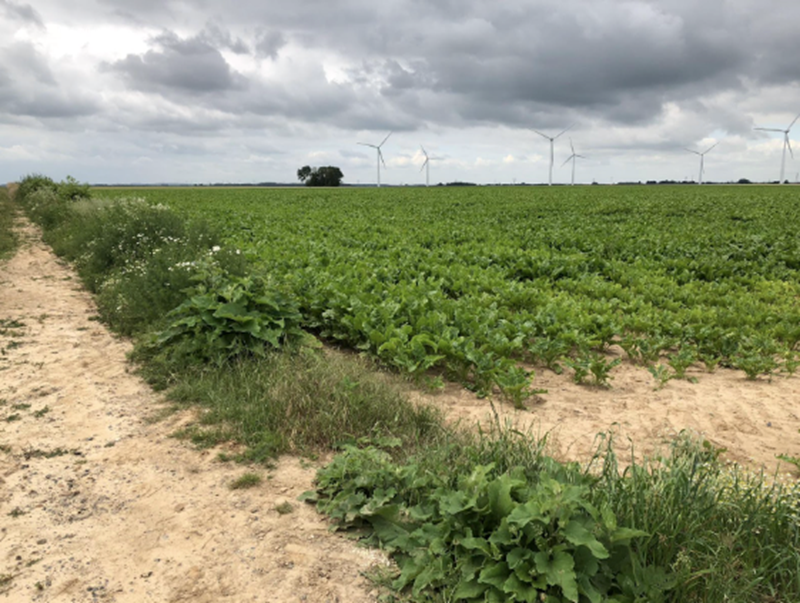
Picture no.17
The following men who were Killed in Action on Sunday 4th February 1917 were buried in Kiboko Wood at the following map coordinates 62C.H.35.b.9.9.
Private G. Walker (8191)
Private E.T. Simpson (5750)
Private William Thomas Amos (20900)
Lance Corporal Edward Bates (21084)
2nd Lieutenant Frances Terence Julian Belcher – B Company.
Private William Camp (20268)
Private A.J. Croker (5412)
Private Christopher Coling (21008)
Private Albert Edward Davies (20983)
Private F.V. Edwards (21043)
Serjeant C. Etheridge (20867)
Private A.D. Evans (20986)
Private Gordon Albine Hipperson (20249)
Private Edwin Plows (21059)
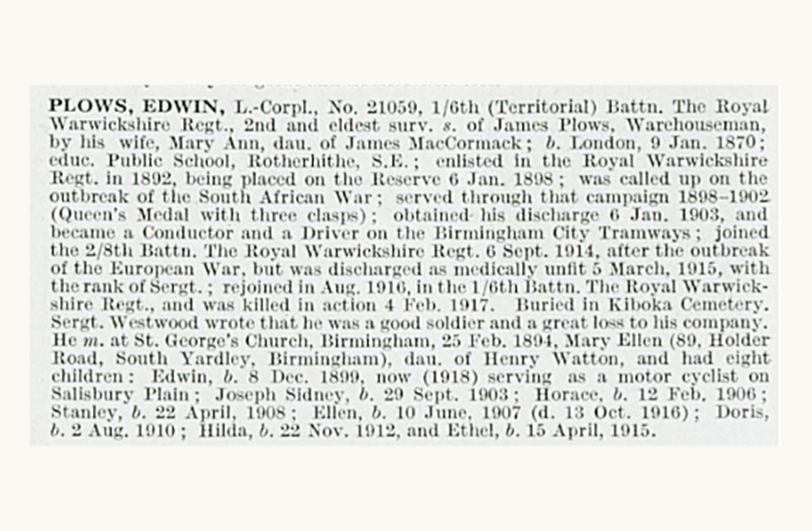
Picture no. 18
Private Thomas Patrick Sharratt (21094)
Private Alexander Robertson Strachan (21189)
Private W. Sturmey (21052)
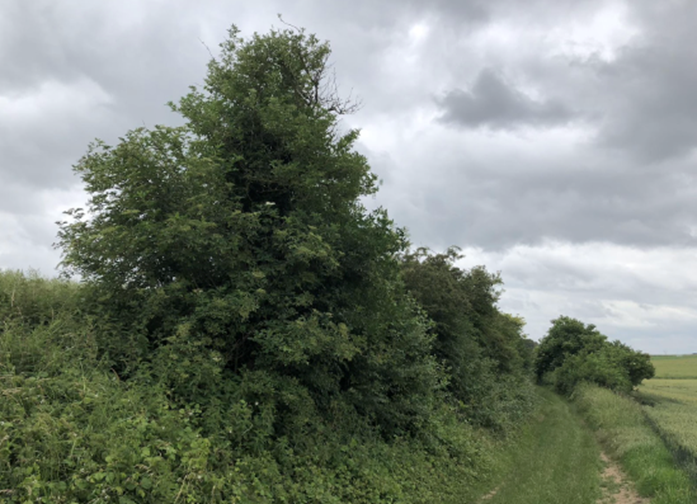
Picture no. 19
The following men were buried at map coordinates 62C.I.31.d.2.8.
Private E. Sharpe (20353)
Private W.C. Whittle (21041)
Drummer S. Saunders (21117)
The following men were buried at map coordinates 62C.I.31.d.1.4.
Serjeant C. Tyler (199)
Private H.E. Bell (20348)
Corporal Charles Albert Grey (5434)
Private W.C. Maidment (21036)
Private Jim Mould (20781)
The following man was buried at map coordinates 62C.I.31.d.2.5.
Drummer C. Harding (21105)
The following men died of wounds and were buried at Esclusier Communal Cemetery.
Private G. Crew (20804)
Private R.E. Lowe (20779)
Private S. Moxon (5574)
The following men’s bodies were never identified and were recorded as missing in The 1/6th Battalion, The Royal Warwickshire Regiment’s War Diary. These men are remembered at Thiepval Memorial to The Missing.
Private Albert Edward Durden (21054)
Private Albert Watson (240272)
Private Alfred Thomas Smith (20978)
Private William Harold White (21013)
Private Frederick Clarence Meek (7647)
Private Christopher John Marshall (242701)
Corporal Albert Victor Worton (2815)
Private Frederick Hewitt (21106)
Private Herbert Harold Kenny (5224)
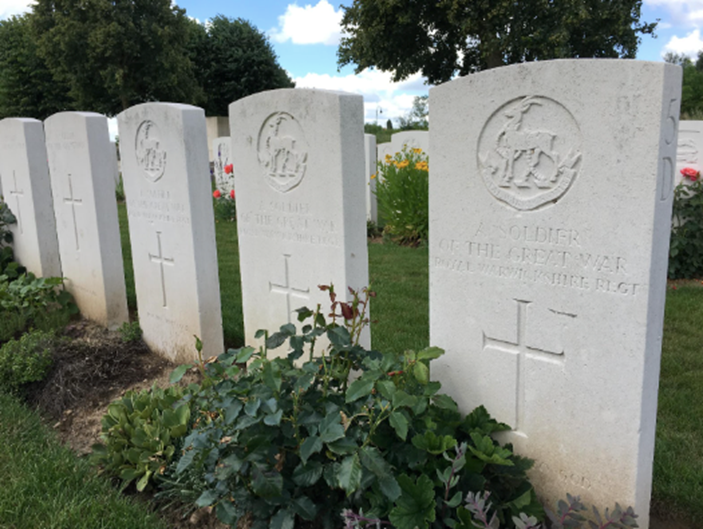
Picture no.20
The following men have a special memorial at Assevillers New British Cemetery.
Private S. Rosinsky (20210)
Private W.F. Mowbray (4123)
Corporal W.G. Perkins (21093)
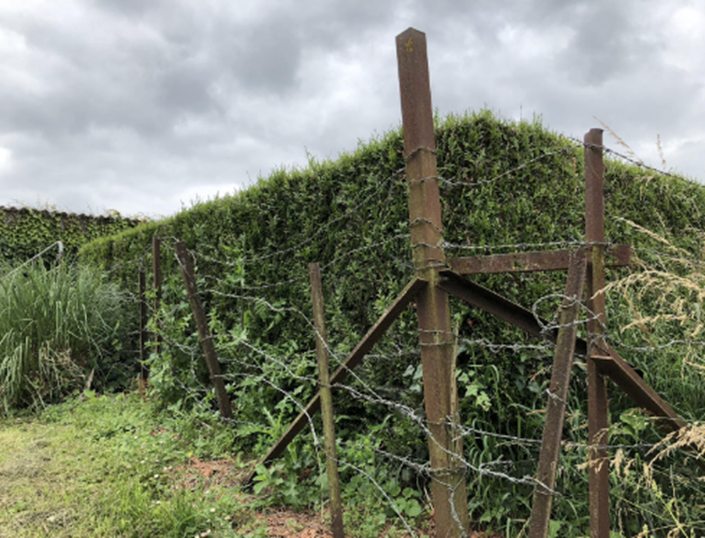
Picture no.20
In his book ‘Some Desperate Glory’, author Vaughan states that;
'He (Watkins) had been leading the company across the open road in front of Herbecourt, when a burst of enemy gunfire swept the road, The company scattered and lay in shell-holes while shells and shrapnel rained about them. Along the front line they saw a terrific barrage falling and faintly distinguished the rattle of machine guns. After a while the shelling suddenly ceased and they went forward with their rations, to find the trenches wrecked but now peaceful. The enemy – The 4th Prussian Guard – had attacked three times, penetrating our lines on the third attempt, chiefly on the sector held by the 6th Warwicks. We had had some casualties, but he did not know how many'.
'This story seriously disturbed my rest: it brought danger so close to me. I lay awake for hours, thinking that I might have been in the line during that barrage and attack, or I might have been in Watkins’ place. Then how would I have acquitted myself? I saw horrible pictures of myself lying dead in a shattered trench, or helplessly bleeding to death in a shell-hole, with no power to call for help. And not less terrible I saw myself on the road, panic-stricken and unable to go forward with the rations. Devoutly I wished that the war would be over before our turn came to go into the line'.
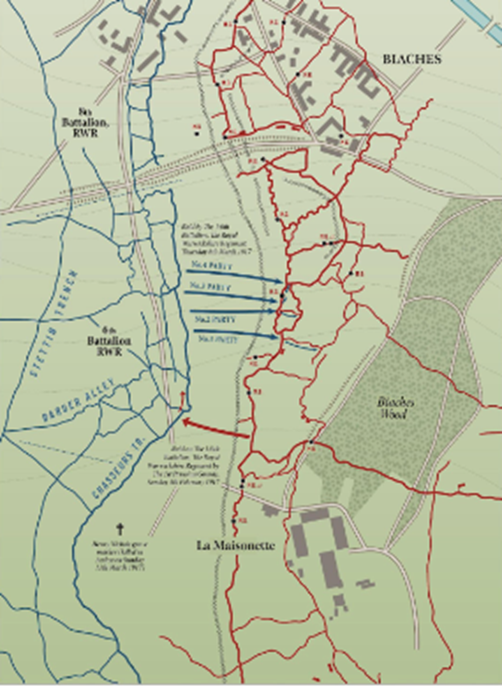
Picture no.21
On Monday 5th February 1917, The 1/6th Battalion, The Royal Warwickshire Regiment was relieved by The 1/5th Battalion, The Royal Warwickshire Regiment. The battalion left their lines and moved into divisional reserve at camp 56 where the battalion received reinforcements of ten other ranks. On Tuesday 6th February 1917, the battalion is listed as being in Divisional Reserve however Private A.J. South (20742) was buried at Bray military Cemetery. From Wednesday 7th February 1917 the battalion was in training where on Friday 9th February it received news that the following men were awarded medals for their bravery following the action of Sunday 4th February 1917.
Captain R.A. Kerr (attached from The Royal Army Medical Corp) awarded the Military Cross
2nd Lieutenant F.B. Williams awarded the Military Cross
2nd Lieutenant J. Harrison awarded the Military Cross
Company Sergeant Major F.W. Billington (20343) awarded the Distinguished Conduct Medal
Corporal F.J. McKay (20839) awarded the Distinguished Conduct Medal
Private T.A. Woskett (5563) awarded the Military Medal
Private C.H. Exley (26253) awarded the Military Medal
Private T. Benzing (1952) awarded the Military Medal
Serjeant W. Channing (2698) awarded Military Medal
Lance Corporal A.E. Bayliss (1531) awarded Military Medal
Serjeant L. Bardell (2624) awarded Bar to Military Medal
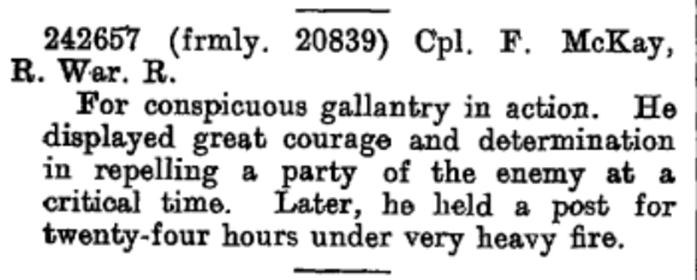
Picture no.22
On Saturday 10th February 1917, The 1/6th Battalion, The Royal Warwickshire Regiment received orders to relieve The 1/5th Battalion, The Royal Warwickshire Regiment that evening in the trenches at Biaches for their second tour in this sector of the trenches.
The battalion was ordered to move at 4:00pm in the following order: C Company, D Company, HQ Company and B Company with 500 yards between platoons. Each soldier was required to wear Fighting Order which due to the weather included every soldier wearing his greatcoat and carrying blankets. No puttees were to be worn and were to be packed into each soldier's valise with each soldier being required to carry a sandbag. Tea would be served in Herbecourt at 4:45. A Company was again ordered to be a working company. The dispositions of the companies in the front line were as follows: D Company on the right and C Company on the left with B Company in support Battalion headquarters was located in Iglau Trench.
On Saturday 11th February 1917, The battalion was in the trenches and suffered one man killed and another man wounded both were caused by an accident. On Sunday 12th February 1917, another other rank was wounded. The battalion received reinforcements of one other rank. On Monday 13th February 1917 nothing was recorded of any consequence in the Battalion War Diary. It was a rare day where The 1/6th Battalion, The Royal Warwickshire Regiment did not suffer any casualties.
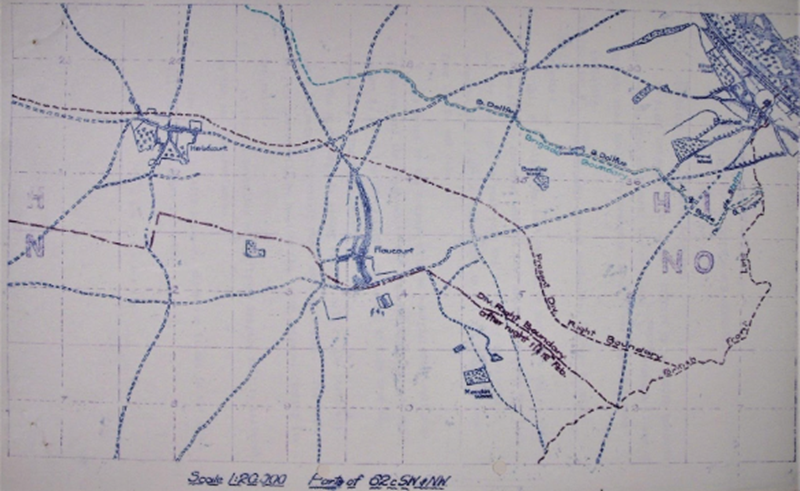
Picture no.23
On Tuesday 14th February 1917 the battalion completed their second tour of the trenches at Biaches and were relieved by The 1/5th Battalion, The Royal Warwickshire Regiment. The Battalion moved to Brigade Reserve in Willikind Trench. From the period Saturday 10th February 1917 to Tuesday 14th February 1917, the battalion suffered the following casualties.
Sunday 12th February 1917, the following man was buried at map coordinate 62C.H.36.7.4.
Private V.O. Hoare (242686)
Sunday 12th February 1917, the following men from The 1/6th Battalion, The Royal Warwickshire Regiment were buried at Bray Military Cemetery.
Private W. Winnitt (3527)
Private F.W. Garlick (20909) - Listed as wounded in action.
On Sunday 12th February 1917, the following man died of his wounds and was buried at St Sever Cemetery, Rouen.
Private F.E. Davis (2736)
Monday 13th February 1917, the following men from The 1/6th Battalion, The Royal Warwickshire Regiment were buried at Bray Military Cemetery.
Corporal William Douglas Hook (1941)
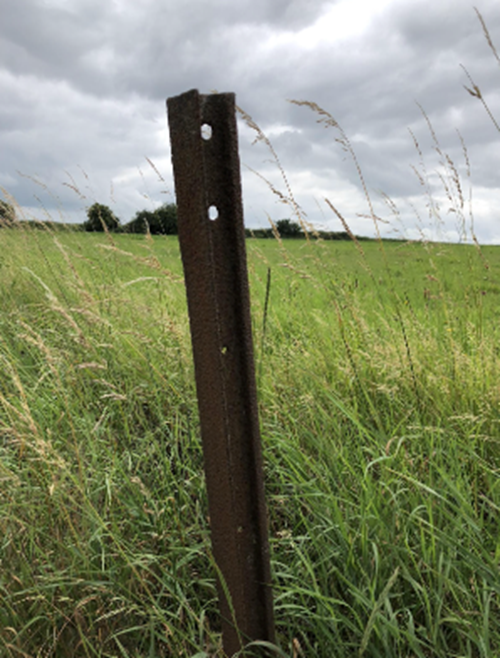
Picture no.24
Edwin Campion Vaughan describes taking over the line at Biaches on 14th February 1917
'Taking over the front line. Moved at dusk up the old Herbecourt road, which is now much softer; the snow is mostly melted and slushy but the ground underneath is still frozen. I knew the way up to Battalion HQ, of course, but from there on was new to me. It was a long and winding trench, which rather bewildered me, for the scattered sentry posts seemed to face in all directions. After a short time, the guide warned me in a whisper that we must now go quietly as we were close to the line.Then the trench got narrower and shallower until it was only knee deep, and we ran into a broken wall of a house. The trench recommenced at the cornet of the building, and here was the entrance to the cellar used as the sergeant majors’ dugout. Here we dropped Sergeant Bell to take over his duties, and we carried on down another 30 years of deep narrow trench where I tore a great rent in my British warm. We hit the front –line trench at right angles, and almost opposite was another cellar into which Hatwell had disappeared in a moment'.
'I hardly noticed the troops melting away into different directions, but suddenly found myself quite alone outside the cellar. For a quarter of an hour I sat up against the side of the trench, soaking in the atmosphere. It was quite dark and damp, around my feet the mud was six inches deep, and above me I could see only the faint outline of the parapet all jagged and broken with bricks and stumps and over it the dim silhouette of loose wire. Occasionally a huge rat would scamper past, or a couple of men would stagger by, swearing gently at their load of sandbags or stakes. All was deathly quiet except for the low voices in the dugout or the faint click of a bayonet against a steel hat'.
'Soon, in twos and threes, men began to dribble back down the way we had come, and then a sturdy sergeant major lifted the blanket of the dugout and reported in a deep confident voice, ‘relief complete. Sir!’. He went steadily off, hoisting his rifle-sling higher on his shoulder and was lost in the darkness. A few minutes later I descended the cellar steps to find a couple of officers finishing their drinks and putting out their cigarettes before they too said goodbye to the line for awhile'.
Vaughan later describes his first experience of visiting the post:
'The night was perfectly quiet, and we picked our squelchy way after Bell along the trench to the right. After ten or twelve yards we turned to the right, ducking under a trench board, and came to the first post. Here, with his head above the parapet, stood private Newey, perfectly motionless. He answered whispered questions without turning his head, and we stood beside him for a few moments peering into the darkness. Nothing could be seen or heard and we stepped down and talked to Corporal Bobby Wood who was in charge of the post. He showed us his shelter, a bare hole scooped out of the side of the trench; his six men were in a tiny shelter on one side'.
'Leaving them to their watch we passed on to the Lewis gun post some dozen yards away. Here Corporal McKay, who was smoking his little pipe upside down, greeted us very cheerily and seemed quite happy. His gun was pushed forward down a little sap, along which we crept quietly to where the gunners were lying face downwards under a belt of wire, with their eyes glued on the faint outline of the ground in front. We could not talk so we returned to the trench'.
'The remainder of the line was very irregular and the posts seemed to be firing in different directions. At the end of our sector on the left, a communication trench ran back to the rear, and a little way down was a nice big shelter in which Sergeant Allsop and one of two men of 14 platoon were sleeping. Close to our third post were two trees, one of which stripped and shattered by a shell, was still standing; the other was cut in half and hung down across the trench like an arch. Under this ran a shallow trench which was a shortcut back to our HQ. This trench we took, walking in the open for nearly 50 years, which I thought a highly dangerous proceeding'.
The following day on Wednesday 15th February 1917, whilst in brigade reserve, Lieutenant E. Spencer joined the battalion for duty.
On Thursday 15th February 1917, Vaughan talks about the grizzly task of burying the dead:
'As I turned to re-enter the dugout, he said 'There's a job for you tonight,' and he pointed out a cluster of corpses three or four years behind the parados. Lying flat on their backs, with marble faces rigid and calm, their khaki lightly covered with frost, some with no wound visible, some with blood clotted on their clothes, one with a perfectly black face, they lay at attention staring up into the heavens. This was my first sight of death and I was surprised that it did not upset me. Only the one with the black face has stayed with me. The thick, slightly curled lips, fleshy aquiline nose, cap-comforter pulled well down over his head and the big glassy eyes have become stamped on my brain'.
'When my tour of duty came round, I drew one or two men from the posts and went out to bury the bodies. It was very dark and we had to feel about finding them. When we tried to dig, we found the ground so hard that we could not get a pick into it. According to orders, also, we tried to take off their boots and equipment, but it was not very pleasant pulling frozen corpses about, so we decided that the country could afford to pay for that equipment, and we ended by covering them with old blankets, and piling the corners with stones, until the ground should be soft enough to bury them.
A few weeks later on Sunday 11th March 1917, Edwin Campion Vaughan makes the following statement "Whilst we were eating, the pioneer sergeant bought in some crosses that he had made for the men whom I had covered with blankets and whom were no buried and when I went to the front line Dunham carried them along'.
On Sunday 11th February 1917 – Monday 12th February 1917, Private V.O. Hoare (5401) was accidently killed with Private F.E. Davies (2736) being listed as having died (the war diary lists that one man died and another man was wounded) this man may possibly be Private W. Winnett who is listed as having died of his wounds.
On Thursday 16th February 1917, the following man died of his wounds and was buried at St Souplet British Cemetery; he is listed as having been taken as a prisoner of war.
Private Frederick William Mander (241770).
On Friday 17th February 1917, another man was accidently wounded. On Saturday 18th February 1917, Private J.W. Loveridge (20921) died of his wounds and was buried at St Sever British Cemetery Rouen.
Monday 20th February 1917, The 1/6th Battalion, The Royal Warwickshire Regiment relieved The 1/5th Battalion, The Royal Warwickshire Regiment for their third tour in the trenches at Biaches. On Tuesday 21st February 1917, 2nd Lieutenant B.F. Dowsett joined the battalion for duty.
On Wednesday 22nd February 1917, the Battalion front was heavily bombarded between 7.40pm and 8.30pm during this bombardment Private David Francis Bermingham (242537) was Killed with one other man being wounded. Private Bermingham’s body was never recovered and he is remembered on The Thiepval Memorial to The Missing. On Thursday 23rd February 1917, the front-line position of The 1/6th Battalion, The Royal Warwickshire Regiment was bombarded at 5.45am killing Private H. Shipway (241187) who was buried by his comrades at map coordinated 62c.I.31.d.2.8.
On Friday 24th February 1917, the battalion received 7 other rank reinforcements and had one other rank wounded. On Saturday 25th February 1917, rumours went around the trenches that “enemy was evacuating” however patrols were sent out and found that the Germans still occupied their posts. On Sunday 26th February 1917, after six days in the trenches the battalion was relieved by The 1/5th Battalion, The Royal Warwickshire Regiment. A patrol was sent out to secure identification however this was not successful and resulted in 2nd Lieutenant Draper being seriously wounded. The Battalion moved into divisional reserve. On this day The 1/6th Battalion, The Royal Warwickshire Regiment received news that the following men had been bestowed awards and honours in The New Year's Awards.
Lieutenant Colonel Danielsen was awarded the Distinguished Service Order.
Lieutenant J. Walker was awarded the Military Cross (Lieutenant Walker was attached to The 143rd Infantry Brigade).
Specially mentioned in dispatches were the following:
Captain J.L. Mellor
2nd Lieutenant J.G. Cooper
Company Sergeant Major T. Waldron (1732) (killed)
Serjeant P.N. Gibbs (2817)
Acting Corporal C. Etheridge (20867)
Acting Lance Corporal W. Brooks (2021)
The battalion spent Sunday 27th February 1917 in Eclusier in the division reserve resting and bathing. On Sunday 27th February 1917 and Monday 28th February 1917, the following men from the battalion died of their wounds and were buried in St Sever Cemetery in Rouen, Private J.E. Thorpe (20341) and Private W.A. Burnham (20237).
As of 28th February 1917, the strength of each battalion within The 143rd Infantry Brigade was as follows.
|
|
Officers |
Other Ranks |
|
Brigade Headquarters |
3 |
11 |
|
The 1/5th Battalion, The Royal Warwickshire Regiment |
34 |
737 |
|
The 1/6th Battalion, The Royal Warwickshire Regiment |
33 |
776 |
|
The 1/7th Battalion, The Royal Warwickshire Regiment |
33 |
779 |
|
The 1/8th Battalion, The Royal Warwickshire Regiment |
25 |
774 |
|
143rd Machine Gun Company |
11 |
174 |
|
Total |
139 |
3251 |
The casualties suffered during the month ending February 28th February 1917 were as follows.
|
|
Killed in Action |
Killed in Action |
Wounded in Action |
Wounded in Action |
Missing in Action |
Missing in Action |
|
|
Officers |
Other Ranks |
Officers |
Other Ranks |
Officers |
Other Ranks |
|
The 1/5th Battalion, The Royal Warwickshire Regiment |
0 |
3 |
0 |
7 |
0 |
0 |
|
The 1/6th Battalion, The Royal Warwickshire Regiment |
1 |
41 |
1 |
84 |
0 |
14 |
|
The 1/7th Battalion, The Royal Warwickshire Regiment |
0 |
1 |
0 |
9 |
0 |
0 |
|
The 1/8th Battalion, The Royal Warwickshire Regiment |
1 |
9 |
0 |
18 |
0 |
0 |
|
143rd Machine Gun Company |
0 |
4 |
0 |
8 |
0 |
0 |
|
Total |
2 |
59 |
1 |
126 |
0 |
14 |
At the beginning of March, The 1/6th Battalion, The Royal Warwickshire Regiment was in Divisional Reserve at Camp 50 located in Eclusier. On Friday 2nd March 1917, two men were wounded whilst on a working party. On Monday 5th March 1917, Serjeant Edwin Dawson (240740) was killed and buried at Eclusier Communal Cemetery. On Wednesday 7th March 1917, the battalion received eight other rank reinforcements.
On Thursday 8th March 1917, The 1/6th Battalion, The Royal Warwickshire Regiment relieved The 1/8th Battalion, The Worcester Regiment for their fourth tour of the trenches at Biaches manning the same sector as their previous tours. The dispositions of the companies were as follows; C Company was located in the front line, B Company was located in Iglau Trench, A Company in Herbecourt and D Company in Willikind. The battalion went up the line in winter fighting order which included greatcoats.
On the night of Wednesday 7th March 1917 and Thursday 8th March 1917, a raid was conducted on the German front line by A Company which began at 9:00pm. The raid was carried out on the German Trench System at map coordinates 62C.I.31.D.
Located in The 143rd Infantry Brigade War Diary is a document entitled ‘Report of Raid By The 6th R. Warwick Regt. On the night of March 8th 1917.
The raid was conducted by A Company and was under the overall command of Captain G. Linfoot under the cover of heavy and field artillery with the raiding party being divided into four parties which were made up as follows.
- 1 officer and 26 other ranks.
- 1 Non Commissioned Officer and 20 other ranks.
- 1 Non Commissioned Officer and 10 other ranks.
- 1 officer and 24 other ranks.
The raiding party of A Company left from British trenches between map coordinates 62C.I.31.d.3070 and 62C.I.31.d.3095 at 9:00pm the covering parties left The British Front Line by posts 4, 5 and 6. 1 officer and 20 other ranks followed the raiding party as a covering party which contained two Lewis Guns. The Covering Party took up a position in No Man’s Land about 50 years from the enemy front line and was positioned on either flank of the raiding party.
The German Front Line was entered at 9:10pm under the cover of a friendly barrage at three separate points. No. 1 party under the command of Lieutenant Seel entered the German Front Line at 62C.I.31.D.78. This party set fire to a dug-out which contained two entrances which faced to the south and killed two men in a sap which ran south west. This party then began to work along the communication trench which ran between map coordinates 62C.I.31.d.78 and 62C.I.31.d.88, a number of dead German soldiers were found.
Party No.2 under the command of a Non Commissioned Officer entered the German front line at map coordinates 62C.I.31.d.69. Where one German soldier was killed this party then cleared the trench as far down as point 62C.I.31.d.79.
Party No 3. under the command of Sergeant Seal entered the enemy front line at point 62C.I.31.d.69 whereupon two dug-outs were set on fire which killed the occupants of these dug-outs as well as capturing two German machine guns and killed one enemy machine gunner. It was noted that seven dead machine gunners were seen.
Party No. 4 under the command of Lieutenant Downing, entered the enemy trenches at point 62C.I.31.d.70 and proceeded along the parapet to point 62C.I.31.d.69 where a dug-out was found. A rifle grenade was shot which wounded two of the soldiers in raiding party No. 4. One P. Bomb and three Mills Bombs were thrown into the dugout setting it on fire. The rear line was also cleared.
Three prisoners were captured who belonged to The 88th Regiment however only two survived. It was reported that the (a) Artillery barrage was excellent which enabled the raiding parties to advance close under it. There were an estimated thirty Germans killed in the raid with friendly losses amounting to one man killed who is believed to be Private George Crick (242136) who was a 44 year old soldier serving with A Company. Two men were severely wounded and 10 men were slightly wounded. At 9:25pm the recall signal was given and at 9:30pm the last man left the German trenches. At 9:40pm friendly artillery commenced fire on The German Front Line following confirmation which had been passed to Battalion Headquarters.
Picture Caption: Location of the British Trench raid which took place on Thursday 8th March 1917. The British front line ran up the field on the right hand side and curved round on the horizon, the German front line ran up the left side of the field in front of the wooded area, the buildings on the horizon of this image is La Maisonette.
Over the course of Thursday 8th March 1917, there were two further men killed from The 1/6th Battalion, The Royal Warwickshire Regiment. Lance Corporal Herbert Henry Read (242564) age 26 from C Company was buried in Kiboko Wood (62C.H.35.b.9.9.) Private Albert Edwin Andrews (240370) has no known grave and is now remembered on The Thiepval Memorial to The Missing.
On Friday 9th March 1917, three men were killed in action, these were, Private F.G. Dart (242805) who is believed to have died of his wounds and is buried at Bray Military Cemetery as well as Lance Corporal J. Baker (242855) and Corporal A.E. Bayliss (240105) both of whom were buried in Kiboko Wood at map coordinates (62C.H.35.B.9.9.).
On Saturday 10th March 1917, the battalion received reinforcements of one other rank. On Sunday 11th March 1917, Private Henry Nichols (242557) and Private Arthur Cresswell (242136) were killed in action and were buried together just in front of The British Front Line Trench at La Maisonette their grave was marked with a cross. On Monday 12th March 1917, 2nd Lieutenant J.W. Bisseker joined the battalion. On Tuesday 13th March 1917, Captain R.H. Lane was granted the military medal. On the evening of Tuesday 13th March 1917 and Wednesday 14th March 1917, the battalion was relieved by The 1/5th Battalion, RWR and moved into Brigade reserve at Camp 50 around Eclusier.
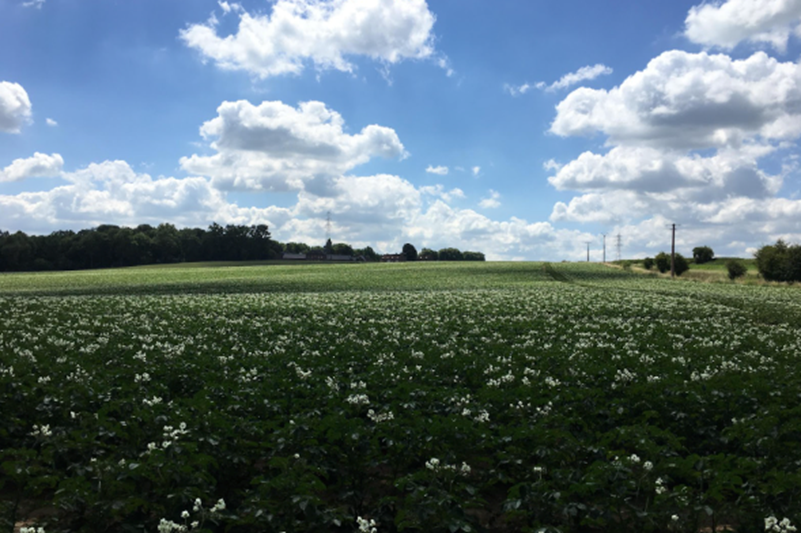
Picture no. 25
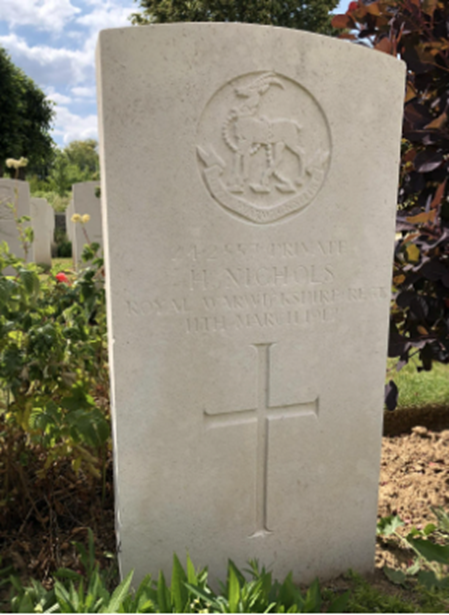
Picture no. 26
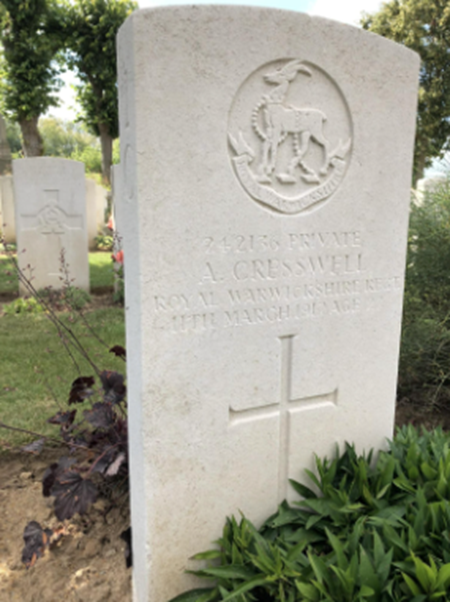
Picture no. 27
On the Sunday 18th March 1917, the battalion moved to Mereaucourt Wood with the HQ and two companies located in the wood, C company located in Herbecourt and D Company located in Wittekind Trench. On Monday 19th March 1917, Private W.G. Davies (5743), Private W.C. Smith (20743), Private C. Doody (20855) were granted Military Medals and on the following day one other rank was accidently wounded in unknown circumstances. On Saturday 24th March 1917, the battalion moved across the river to Peronne which they must have seen from a distance from their trenches facing La Maisonette during the long months of February and March 1917. By the end of March 1917, The German Army started to withdraw to The Hindenburg line which marked the end of a period of static warfare around Biaches. On Thursday 29th March 1917, Private J.H. Millward was recorded as having died as a prisoner of war in Germany and is now buried in Cologne Southern Cemetery.
On Tuesday 27th March 1917, sixteen days after Henry was killed in action, his family received notification of his death. Henry, left behind his wife, Mary Elizabeth Nichols and three children Agnes, Victor and Olive. In December 1917, Henry’s father, Richard Nichols passed away and was buried in the family plot at The London Road Cemetery in Coventry which marked the end of a tough year for the whole of the Nichols family. In April 1917, The Coventry Evening Standard reported in the news from Brinklow that Private Henry Nichols, Royal Warwickshire Regiment was killed in action in France on March 11th. He had joined the forces in March, 1916 and had been in France eight months, and although of a reserved disposition he made a good soldier. In private life he was occupied in Coventry, and had been residing in Brinklow for nearly four years. Much sympathy is felt for Mrs Nichols, who has three young children, the eldest being only five years of age.
|
Rank and Name of Soldier |
Age |
Serial Number |
Date of Death |
Location of Burial |
Next of Kin |
|
Private S Rosinsky |
20210 |
04/02/1917 |
Special Memorial. |
||
|
Private Thomas Patrick Sharratt |
41 |
2094 |
04/02/1917 |
Kiboko Wood Cemetery - 62C.H.35.B.9.9. |
Husband of M.A Sharratt of Tamworth. |
|
Private Alexander Robertson Strachan |
24 |
21189 – C company. |
04/02/1917 |
Kiboko Wood Cemetery - 62C.H.35.B.9.9. |
Son of William and Helen Strachen of Aberdeen. |
|
Private Walter Sturmey |
26 |
21052 |
04/02/1917 |
Kiboko Wood Cemetery - 62C.H.35.B.9.9. |
Son of Frederick and Ellen Sturmey of Dorset. |
|
Sergeant C. Tyler |
199 – B Company? |
04/02/1917 |
62C.I.31.D.4.1. |
||
|
Private H.E. Bell |
20348 |
04/02/1917 |
62C.I.31.D.1.4. |
||
|
Private William Camp |
24 |
20268 – C company. |
04/02/1917 |
Kiboko Wood Cemetery - 62C.H.35.B.9.9. |
Son of James and Elizabeth Camp of Hertfordshire. |
|
Private Albert Edward Davies |
23 |
20983 – C company. |
04/02/1917 |
62C.H.35.b.9.9. |
Son of John and Sarah Davies of Gloucester. |
|
Drummer S. Sanders |
21117 |
04/02/1917 |
62C.I.31.D.2.2. |
||
|
Corporal Charles Albert Grey |
25 |
5434 |
04/02/1917 |
62C.I.31.D.4.1. |
Son of Mrs Elizabeth Grey of Henly on Thames. |
|
Private W.C. Maidment |
21036 |
04/02/1917 |
62C.I.31.D.1.4. |
||
|
Private W.F. Mowbray |
4123 |
04/02/1917 |
Special Memorial. |
||
|
Corporal W.G. Perkins |
32 |
21093 |
04/02/1917 |
Son of William and Hannah Perkins of Birmingham. Special Memorial. |
|
|
Private E.T. Simpson |
5750 |
04/02/1917 |
Kiboko Wood Cemetery - 62C.H.35.B.9.9. |
||
|
Private William Thomas Amos |
24 |
20900 – C company. |
04/02/1917 |
Kiboko Wood Cemetery - 62C.H.35.B.9.9. |
Son of Mrs Sarah Amos of Rugby. |
|
Lance Corporal Edward Bates |
24 |
21084 |
04/02/1917 |
Kiboko Wood Cemetery - 62C.H.35.B.9.9. |
Son of John and Sarah Bates. |
|
Private A.J. Crocker |
5412 |
04/02/1917 |
Kiboko Wood Cemetery - 62C.H.35.B.9.9. |
||
|
Private Christopher Coling |
21 |
21008 - C company. |
04/02/1917 |
Kiboko Wood Cemetery - 62C.H.35.B.9.9. |
Son of Mr and Mrs Coling of Rugby. |
|
Private A.D. Evans |
20986 |
04/02/1917 |
Kiboko Wood Cemetery - 62C.H.35.B.9.9. |
||
|
Private F.V. Edwards |
21043 – C company. |
04/02/1917 |
Kiboko Wood Cemetery - 62C.H.35.B.9.9. |
||
|
Private Albine Gordon Hipperson |
20249 – C company. |
04/02/1917 |
Kiboko Wood Cemetery - 62C.H.35.B.9.9. |
Husband of Annie Hipperson of Coventry. |
|
|
Sergeant C. Etheridge (listed as an acting corporal on Monday 26th February 1917). |
20867 – C company. |
04/02/1917 |
Kiboko Wood Cemetery - 62C.H.35.B.9.9. |
||
|
Drummer C. Harding |
21105 |
04/02/1917 |
62C.I.31.D.2.8. |
||
|
Private Jim Mould |
28 |
20781 |
04/02/1917 |
62C.I.31.D.1.4. |
Son of Frank and Elizabeth Mould of Salisbury. |
|
Private Edwin Plows |
47 |
21059 – C Company. |
04/02/1917 |
Kiboko Wood Cemetery - 62C.H.35.B.9.9. |
Son of James and Mary Ann Plows of Birmingham. |
|
Private Harold William White |
21013 |
04/02/1917 |
Never recovered and remembered on The Thiepval Memorial to The Missing. |
||
|
Private Alfred Thomas Smith |
22 |
20978 |
04/02/1917 |
Never recovered and remembered on The Thiepval Memorial to The Missing. |
Son of George and Elizabeth Smith. |
|
Private E. Sharpe |
20353 |
04/02/1917 |
62C.I.31.D.2.8. |
||
|
Private W.C. Whittle |
21041 |
04/02/1917 |
62C.I.31.D.2.8. |
||
|
Corporal Albert Victor Worton |
26 |
2815 |
04/02/1917 |
Never recovered and remembered on The Thiepval Memorial to The Missing. |
Son of Thomas and Margret Worton of Harborne. |
|
Private Albert Edward Durden |
21054 |
04/02/1917 |
Never recovered and remembered on The Thiepval Memorial to The Missing. |
||
|
Herbert Harold Kenney |
5224 |
04/02/1917 |
Ongoing research. |
||
|
Private Frederick Hewitt |
21106 |
04/02/1917 |
Never recovered and remembered on The Thiepval Memorial to The Missing. |
||
|
Private Albert Watson |
240272 |
04/02/1917 |
Never recovered and remembered on The Thiepval Memorial to The Missing. |
||
|
Private R.E. Lowe |
20779 |
04/02/1917 |
Wounded and buried in Eclusier Communal Cemetery. |
||
|
Private G. Crew |
20804 |
04/02/1917 |
Wounded and buried in Eclusier Communal Cemetery. |
||
|
Private S. Moxon |
5574 |
04/02/1917 |
Wounded and buried in Eclusier Communal Cemetery. |
||
|
Private Christopher John Marshall |
20 |
242701 |
04/02/1917 |
Never recovered and remembered on The Thiepval Memorial to The Missing. |
|
|
Private Frederick Clarence Meek |
7647 |
04/02/1917 |
Never recovered and remembered on The Thiepval Memorial to The Missing. |
||
|
Private G. Walker |
3191 – C company. |
04/02/1917 |
Never recovered and remembered on The Thiepval Memorial to The Missing. |
|
Private F.W. Garlick |
27 |
20909 |
08/02/1917 |
Bray Military Cemetery. |
Son of William and Jane Garlick. |
|
Lance Corporal J. Baker |
242885 |
09/03/1917 |
Kiboko Wood Cemetery - 62C.H.35.B.9.9. |
||
|
Private Arthur Cresswell |
22 |
242136 |
11/03/1917 |
62C.I.31.D.1.1. |
|
|
Private George Crick |
44 |
242158 – A company. |
08/03/1917 |
63C.I.31.D.3.9. |
Son of Sam and Eliza Crick. |
|
Lance Corporal Herbert Henry Read |
26 |
242564 – C Company |
09/03/1917 |
Kiboko Wood Cemetery - 62C.H.35.B.9.9. |
Son of Silvanus and Sarah Read of Rugby. |
|
Private Henry Nichols |
31 |
242557 |
11/03/1917 |
62C.I.31.D.1.1. |
Son of Richard and Eliza Nichols of Coventry. |
|
Private H. Shipway |
241187 |
23/02/1917 |
62C.I.31.D.2.8. |
||
|
Corporal A.E. Bayliss |
240105 |
09/03/1917 |
Kiboko Wood Cemetery - 62C.H.35.B.9.9. |
||
|
Private V.O. Hoare |
241686 |
12/02/1917 |
Buried close to Dolfus Trench - 62C.H.36.A.7.4. |
||
|
Private F.G. Dart |
22 |
242805 |
09/03/1917 |
Bray Military Cemetery. |
Son of James and Isabella Dart of Bristol. |
|
Corporal William Douglas Hook |
22 |
1941 |
13/03/1917 |
Bray Military Cemetery. |
Son of Richard and Fanny Hook of Worcester. |
|
Private A.J. South |
28 |
20742 |
06/02/1917 |
Bray Military Cemetery. |
Son of Joseph T. and H. South of Fosehill Road, Coventry. |
|
Private W. Winnett |
20 |
3527 |
12/02/1917 |
Bray Military Cemetery. |
Son of Mrs Winnet of Birmingham. |
|
Private David Francis Bermingham |
242537 |
22/02/1917 |
Never recovered and remembered on The Thiepval Memorial to The Missing. |
||
|
Private J.W. Loveridge |
33 |
20921 |
18/02/1917 |
St. Sever Cemetery Extension. |
Son of Frederick and Eliza Loveridge of Coventry. |
|
Private F.E. Davis |
2736 |
12/02/1917 |
St. Sever Cemetery Extension. |
||
|
Private Albert Edwin Andrews |
240370 |
08/03/1917 |
Never recovered and remembered on The Thiepval Memorial to The Missing. |
||
|
Private W.A. Burnham |
20237 |
28/02/1917 |
St. Sever Cemetery Extension. |
Son of Mrs Burnham of Birmingham. |
|
|
Segeant Edwin Dawson |
36 |
240740 |
05/03/1917 |
Eclusier Communal Cemetery. |
Son of the late Edwin and Susannah Dawson of Birmingham. |
|
Private J.E. Thorpe |
20341 – D Company |
27/02/1917 |
St. Sever Cemetery Extension. |
Son of John and Mary Ann Thorpe of Leicester. |
|
|
Private Frederick William Mander |
29 |
241770 |
16/02/1917 |
St. Souplet British Cemetery. |
Husband of Jenny Mander of Birmingham |
|
Private P.J. Fegan |
62996- The 143rd Machine Gun Company. |
06/02/1917 |
Bray Military Cemetery. |
||
|
Private S. Kendall |
9997 – The 143rd Machine Gun Company. |
11/03/1917 |
62C.H.35.B.9.9. |
||
|
Private I. Lord |
27186 - The 143rd Machine Gun Company. |
06/02/1917 |
62C.H.36.A.7.4. |
||
|
Private Robert Fletcher |
18 |
36696 - The 143rd Machine Gun Company. |
04/02/1917 |
63C.I.31.D.3.7. |
Son of Robert and Margret Fletcher of Manchester. |
|
Lance Corporal S.H. Falconbridge |
24400 - The 143rd Machine Gun Company. |
06/02/1917 |
62C.I.31.D.2.7. |
||
|
Private Alfred James Griffiths |
36588 - The 143rd Machine Gun Company. |
06/02/1917 |
62C.I.31.D.2.7. |
Son of Alfred and Jessie Griffiths of London. |
|
|
Lance Corporal T. Philips |
23075 - The 143rd Machine Gun Company. |
06/02/1917 |
63C.I.31.D.2.7. |
||
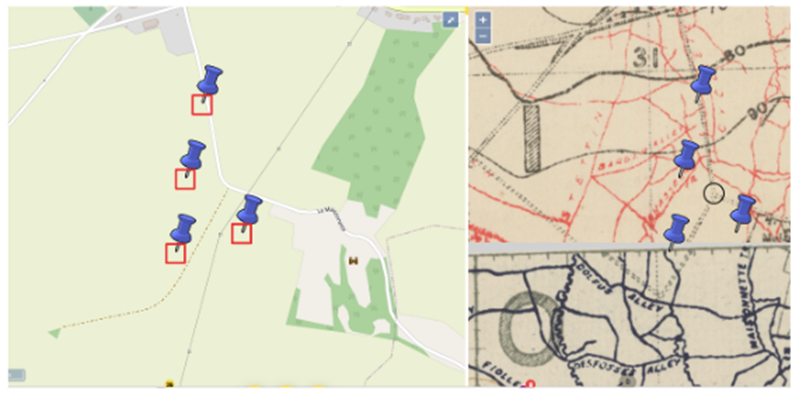
Picture no.28
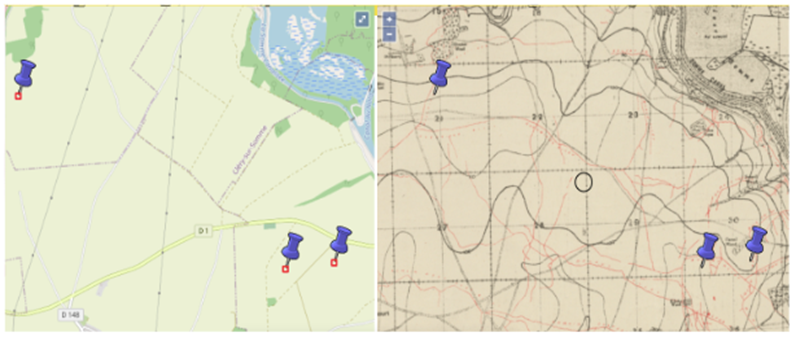
Picture no. 29
A Walk Around Biaches
Starting in Herbecourt, follow the D1 Rue De Cappy onto the D1 Rue De Peronne. During February 1917 and March 1917, this road would have seen much activity with men and supplies moving up to the front line and wounded men being transported back down this road via motor ambulances. As you walk or drive down this road on the right you will see the village of Flaucourt which was a forward position for the collection of men and supplies.





